6 Challenges for Science Educators

- Share article
From time to time, science education rises to the forefront of national consciousness.
That happened most prominently in the late 1950s and early 1960s after the Russians beat the United States into space with the launch of Sputnik. But science education became a national concern again, in the early aughts, when a panel of businesspeople, scientists, and educators warned of a “gathering storm” as the United States stood to lose its economic, scientific, and technological edge over the rest of the world and called for investing billions of dollars in science education to head off the problem.
This isn’t one of those times.
In fact, science is having a bit of a public relations crisis now. Hefty segments of the public mistrust the scientific consensus , whether it’s on the causes of climate change, the safety and efficacy of the vaccines created to combat COVID-19, or the seriousness of the threat posed by the virus. And misperceptions and falsehoods about science flood the internet.
K-12 science education has a role to play in solving this problem . By teaching students to think like scientists as they weigh information and grounding them in scientific concepts and processes, teachers can help build credibility and trust for the field over time. That challenge is a focus of this special report .
But the crisis of confidence that confronts the field now is just the latest 21st-century challenge for science education. Here are more:
- Flat or declining science achievement. Results of the latest National Assessment of Educational Progress in science , given in 2019, showed that 4th graders’ performance in that subject declined, while average scores flatlined in grades 8 and 12 since the last assessment in 2015. More than a third of all 8th graders—including nearly 60 percent of all Black students and nearly half of Hispanic and Native American students—performed below even the “basic” level of science competency.
- A shrinking share of the curriculum. Elementary students spend on average only 20 minutes per day on science instruction, compared with 60 minutes daily for math and 90 minutes each day for reading and language arts, says a report released this year by another call-to-action national panel of scientists and educators. (This report from the National Academies of Sciences, Engineering, and Medicine attracted less attention, however, than the organization’s 2005 report warning about the gathering storm.)
- Instructional inequities. Too many students lack access to a full complement of advanced science courses, and many of those students are in schools with high concentrations of Black and brown students. Physics, for instance, is not offered as a course in 59 percent of high-minority high schools and 31 percent of low-minority high schools. No chemistry class is taught in 42 percent of high-minority high schools, and 18 percent of those with mostly white students, according to the National Academies.
- Teacher preparation. Only 31 percent of educators say they feel prepared to teach general science. At the high school level, the national science panel says, 58 percent of biology teachers felt prepared to teach about ecology and ecosystems.
- Lack of diversity among teachers. The general lack of diversity that characterizes the nation’s teaching force is amplified among teachers of science. Eight of 10 public elementary, middle school, and high school science teachers are white, according to the National Academies report.
Then, of course, there’s the pandemic. The COVID-19 school shutdowns put a crimp in instruction across the board, but anecdotally at least, there is some evidence to show that science took a particularly hard hit as schools focused on the basics and remote learning made hands-on scientific inquiry more difficult to do.
The irony is that COVID-19 presents a perfect opportunity to explore science in a way that touches students’ lives. But the polarized politics gripping the country over both scientific and nonscientific issues has made some reluctant to try.

A version of this article appeared in the November 24, 2021 edition of Education Week as 6 Challenges for Science Educators


Sign Up for EdWeek Update
Edweek top school jobs.

Sign Up & Sign In

Thank you for visiting nature.com. You are using a browser version with limited support for CSS. To obtain the best experience, we recommend you use a more up to date browser (or turn off compatibility mode in Internet Explorer). In the meantime, to ensure continued support, we are displaying the site without styles and JavaScript.
- View all journals
- Explore content
- About the journal
- Publish with us
- Sign up for alerts
- Perspective
- Published: 02 July 2018
Science education in the 21st century
- Sun Kwok 1 nAff2
Nature Astronomy volume 2 , pages 530–533 ( 2018 ) Cite this article
741 Accesses
11 Citations
29 Altmetric
Metrics details
- Astronomy and planetary science
The traditional university science curriculum was designed to train specialists in specific disciplines. However, in universities all over the world, science students are going into increasingly diverse careers and the current model does not fit their needs. Advances in technology also make certain modes of learning obsolete. In the past ten years, the Faculty of Science of the University of Hong Kong has undertaken major curriculum reforms. A sequence of science foundation courses required of all incoming science students are designed to teach science in an integrated manner, and to emphasize the concepts and utilities, not computational techniques, of mathematics. A number of non-discipline-specific common core courses have been developed to broaden students’ awareness of the relevance of science to society and the interdisciplinary nature of science. By putting the emphasis on the scientific process rather than the outcome, students are taught how to identify, formulate, and solve diverse problems.
This is a preview of subscription content, access via your institution
Access options
Access Nature and 54 other Nature Portfolio journals
Get Nature+, our best-value online-access subscription
24,99 € / 30 days
cancel any time
Subscribe to this journal
Receive 12 digital issues and online access to articles
111,21 € per year
only 9,27 € per issue
Buy this article
- Purchase on Springer Link
- Instant access to full article PDF
Prices may be subject to local taxes which are calculated during checkout
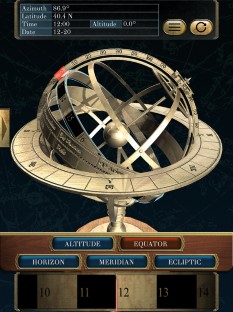
Technology-Enriched Learning Initiative of the University of Hong Kong.
Similar content being viewed by others
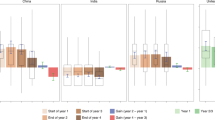
Skill levels and gains in university STEM education in China, India, Russia and the United States
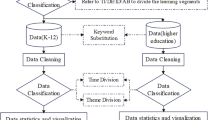
Subject integration and theme evolution of STEM education in K-12 and higher education research

Fostering twenty-first century skills among primary school students through math project-based learning
Heffron, J. M. The knowledge most worth having: Otis W. Caldwell (1869–1947) and the rise of the general science course. Sci. Educ. 4 , 227–252 (1995).
Article Google Scholar
A Nation at Risk: The Imperative for Education Reform (National Commission on Excellence in Education, 1983).
Jaffee, D. The general education initiatives in Hong Kong: organized contradictions and emerging tensions. High. Educ. 64 , 193–206 (2012).
Kwok, S. Our Place in the Universe: Understanding Fundamental Astronomy from Ancient Discoveries . (Springer, Berlin, 2017).
Adams, J. V. Student evaluations: the ratings game. Inquiry 1 , 10–16 (1997).
Google Scholar
Deslauriers, L., Schelew, E. & Wieman, C. Improved learning in a large-enrollment physics class. Science 332 , 862–864 (2011).
Article ADS Google Scholar
Download references
Acknowledgements
I thank my HKU colleagues who helped me implement the curriculum reform at HKU, in particular N. K. Tsing and E. K. F. Lam, who were instrumental in the design of the science foundation courses. I am grateful to H. C. von Bergmann and C. Pennypacker of the Global Science Education Network for their advice on the reform.
Author information
Present address: Department of Earth Ocean and Atmospheric Sciences, University of British Columbia, Vancouver British, Columbia, Canada
Authors and Affiliations
Dean of Science from 2006 to 2016, University of Hong Kong, Hong Kong, China
You can also search for this author in PubMed Google Scholar
Corresponding author
Correspondence to Sun Kwok .
Ethics declarations
Competing interests.
The author declares no competing interests.
Additional information
Publisher’s note: Springer Nature remains neutral with regard to jurisdictional claims in published maps and institutional affiliations.
Rights and permissions
Reprints and permissions
About this article
Cite this article.
Kwok, S. Science education in the 21st century. Nat Astron 2 , 530–533 (2018). https://doi.org/10.1038/s41550-018-0510-4
Download citation
Received : 14 May 2018
Accepted : 04 June 2018
Published : 02 July 2018
Issue Date : July 2018
DOI : https://doi.org/10.1038/s41550-018-0510-4
Share this article
Anyone you share the following link with will be able to read this content:
Sorry, a shareable link is not currently available for this article.
Provided by the Springer Nature SharedIt content-sharing initiative
Quick links
- Explore articles by subject
- Guide to authors
- Editorial policies
Sign up for the Nature Briefing newsletter — what matters in science, free to your inbox daily.
- Book review
- Open access
- Published: 11 October 2023
Gregory P. Thomas and Helen J. Boon: Challenges in science education: global perspectives for the future
Switzerland, 2023, 311 pp, ISBN 978-3-031-18091-0
- Utari Akhir Gusti ORCID: orcid.org/0009-0005-8419-5988 1 &
- Mia Komariah ORCID: orcid.org/0000-0002-5082-7087 2
Smart Learning Environments volume 10 , Article number: 49 ( 2023 ) Cite this article
1041 Accesses
Metrics details
Science education is one of the most important materials that students learn in their lives. Through this subject, they will learn about the phenomena that might be happening on the earth. A book by Gregory P. Thomas and Helen J. Boon with the title Challenges in Science Education: Global Perspectives for The Future delivered everything about how teachers could teach science to students in this century. This book will give the readers knowledge about how science can be taught in many ways and for different purposes. Besides that, this book also gives some ideas about the challenges that might teachers face during the learning process.
This book consists of 13 chapters regarding science teaching which are discussed based on research that has been carried out by several researchers which were then compiled by Gregory P-Thomas and Helen J. Boon, with great care. As a very important branch of knowledge to learn through, science students are expected to be able to solve natural phenomena and protect and appreciate everything on this earth better. This book described various studies on how to teach science and suggestions that can be used as a reference in teaching science, both for the present and for the future. This book was compiled based on research conducted on science teachers, experience, and literature studies from various sources.
The first chapter of this book described the various challenges and choices in science education. This chapter was written by Gregory P. Thomas (Professor of Science Education at the University of Alberta, Canada) and Helen J. Boon (Professor of education at James Cook University), revealed that challenges and choices in learning can become opportunities in advancing education science itself. The challenges faced in learning science such as science content, teacher pedagogy, and technological developments. The choices in teaching vary widely because the learning relates to living things and the environment science. In this section, it was also conveyed that the lack of references about science education was a challenge in learning.
The second chapter by Tanya Doyle discussed the direction of the movement or the blueprint for science education in Australia. This was reflected in the science education curriculum that will be used by Australia. There are various considerations in determining the policy direction or blueprint for science education in Australia, such as the analysis of deliberative rhetoric, the circumstances, goals, and actions underpinning Australia's quantum age of science. The circumstances included the drive toward the quantum age; goals included economic growth and geophysical security through critical technologies; actions included the drive for impact through investment in quantum technology. These three components were mutually integrated to support the development of education. Besides that, this section also provided an overview of the next steps for science education in Australia, future challenges, and opportunities for science educators.
In the third chapter, which was written by Robyn M. Gillies, he proposed teaching science based on inquiry. This section explained in detail about inquiry-based science such as evidence of success and effectiveness in learning through inquiry. Besides that, it also described the challenges that may be faced in teaching science with inquiry-based. The interesting thing in this chapter was the explanation of the approach used for inquiry-based learning in science. This approach was the 5E model, which was one approach to teaching inquiry-based science that has a strong evidence-based 5E instructional model proposed by Bybee et al. ( 2015 ). This model consisted of five phases of learning: engage, explore, explain, elaborate, and evaluate. Not only that, it also explained about being cooperative to learn, scientific literacy, and scientific discourse, to support the implementation of science inquiry-based learning. This section emphasized the application of inquiry-based in science learning with various evidence and recommendations for its implementation.
Furthermore, chapter four discussed Educating About Mass Vaccinations in a Post-Truth Era by Subhashni Taylor, Neil Taylor, and Penelope Baker which suggested the role of science in solving social-science problems that occurred in society. The form of solving social problems presented was in the form of vaccines. This section revealed various truths about vaccines that have been in conflict and have been rejected, especially in America and Australia. This was because science was able to answer scientifically, logically, and completely. What makes this chapter special is that it could provide evidence of the importance of science in solving growing social problems which was in this case discussed the history of vaccine development, the role of the anti-vaccination movement and the media, the role of social media related to vaccine information, the role of education, and less formal approaches. In addition, science was also able to oppose various rejections and concerns of society with an innovation.
The next one is chapter five by William R. Veal, Patricia D. Morrell, Meredith A. Park Rogers, Gillian Roehrig, and Eric J. Pyle which explained their findings regarding the importance of teacher quality in teaching science, especially in developing countries. Teacher quality affects student learning outcomes. Thus, the quality of teachers needs to be improved in order to produce the quality of science learning. This chapter emphasized the findings regarding Science Teachers Preparation (STP), including matters affecting STP, namely Neoliberal and Complex Systems Approaches, Social Justice, and its sustainability.
Chapter six explained the teacher's role in teaching science such as Everyday Science for Building Schoolchildren's Informed Agency for Action (Helen J. Boon and Donna Rigano). This section explained the urgency of the elementary school teachers' role in teaching science. The role of the elementary school teacher was important because this stage is the beginning or embryo of the formation of knowledge. The science for the next stage. This stage was also the beginning of the formation of science agents so that they were able to build a science that was close to everyday life and was indeed carried out in everyday life. Strengthening and improving the quality of teachers is a must in order to create science agents in life. So, this chapter emphasized that teachers and science were inseparable parts.
Chapter seven on Pre-service Elementary Teachers as Game Designers: Emotional Experiences from the Field written by Laura Martín-Ferrer, Elizabeth Hufnagel, Arnau Amat, Mariona Espinet, and Alberto Bellocchi. This section discussed how to teach science using games. This discussion focused on the implementation of science teaching with games by Pre-Service Teachers (PST). Despite that, it also explained how games affect the students’ emotions and teachers in learning science. So, with Game-Based Learning (GBL) it can create fun learning by paying attention to PST in order to support the implementation of science learning with games.
Chapter eight on The Nature of Teacher Educators' Professional Learning: Reflections of Two Science Teacher Educators by Karen Goodnough and Saiqa Azam. This section discussed trials conducted on 2 science teachers regarding the development of knowledge, skills, and pedagogic Teacher Candidates (TCs) to create professional learning (PL) in school. Using the framework by Ping et al. ( 2018 ) which consisted of three categories: the 'what' or content of PL, the 'how' or activities of PL, and the 'reasons' or why for PL. In addition, it was also explained that in order to become a professional science teacher, preparation and coaching were needed from college to continuing teaching. Not only focusing on science contents, this chapter placed more emphasis on the pedagogy of teaching science to students. So, the learning material can be well received by students.
Then, chapters nine, ten, and eleven discussed STEM in learning. In Chapter Nine Breaking the Vicious Circle of Secondary Science Education with Twenty-First-Century Technology: Smartphone Physics Labs written by Marina Milner-Bolotin and Valery Milner. This section discussed how the role of technology and information helped in science learning. This also supported the implementation of STEM in learning. Teacher’s skills in using information technology are one of the skills that have to be mastered in the application of professional learning and encourage students to be active during learning. This section emphasized the use of technology to support physics labs in learning science.
In chapter ten on Science and Technology Studies Informing STEM Education: Possibilities and Dilemmas by Majd Zouda, Sarah El Halwany, and Larry Bencze. This chapter explained the role of information technology in the implementation of STEM in learning. This section provided an illustration that STEM supported teachers in applying meaningful learning to students. In addition, STEM encouraged students to apply the knowledge gained at school to solve surrounding problems it increased students' abilities and interest in learning. The limitations of the curriculum, infrastructure, and teachers’ quality were a dilemma in its application. Thus, these limitations become opportunities for research and assessment to improve learning.
In chapter eleven on Using Animals in Education as a Means of Discovering Meaningful Contexts to Enhance Learning and Motivate Learners: Challenges and Opportunities to Integrate and Broaden STEM Education by John Cavalieri. This section discussed the role of STEM learning in supporting students’ careers in the future. One of the efforts to maximize STEM learning in schools was by using animals. In this case, animals provide meaningful learning to students because they learn directly from real objects while still paying attention to ethics towards animals.
In chapter twelve, which discussed "Instruction for Metacognition in Science Classrooms: Harsh Realities and a Way Forward" written by Gregory P. Thomas. This section addressed the culmination of demands in science education, which was the metacognitive skills of the learners. This aspect was closely tied to the role of teachers in supporting students' metacognition. However, metacognition is often overlooked in the learning process. Therefore, collective efforts are needed to enhance it.
In chapter thirteen of Identifying and Challenging the Narrow Cognitive Demands of Science Textbooks by Claudia E. Johnson and Helen J. Boon. This section revealed the importance of readiness and the availability of reading materials in enhancing students' metacognition. Therefore, when writing books, curriculum, students, and STEM should be taken into consideration to realize professional learning. The reading materials should not only analyze concepts but also emphasize the utilization of that knowledge. The readiness of instructional materials became a determining factor in the achievement of learning, yet this aspect was often overlooked. In this section, the author emphasized that metacognition was crucial in meaningful science education and required special attention to improve the learning's quality.
Learning science is very important in the world of education. Various choices can be made to improve the quality of learning science. Amid the rapid development of technology and information, it becomes a challenge to improve the quality of science learning. So, it is necessary to take advantage of all available opportunities so that people be able to face the challenges of learning science in the future. This book systematically explained the opportunities and challenges of learning science in the present and the future. Thus, it helped the reader to think systemically. In addition, this book was equipped with scientific evidence such as direct research. This helped science teachers in learning because it has been tested through research. The identified weakness in this context was the inconsistency or absence of the section numbering. Furthermore, the spacing between the headings and the next section was too far apart, as in the index, contents, notes on contributors, list of figures, and list of tables. The table appearance was black and white and inconsistent in using numbers/letters as reading points. Overall, this book will be very useful for science teachers to improve the quality of their science teaching and learning experiences. Through this book, science teachers will get a clear picture of how science should be taught and future challenges that will be faced so that teachers can take appropriate action in teaching science to their students.
Availability of data and materials
Not applicable.
Abbreviations
Science Teachers Preparation
Pre-Service Teachers
Teacher Candidates
Game-based learning
Professional learning
Science, Technology, Engineering, and Mathematics
Engage, explore, explain, elaborate, and evaluate
Bybee, R., Taylor, J. A., Gardner, A., Van Scotter, P., Carlson Powell, J., Westbrook, A., & Landes, N. (2015). The BSCS 5E instructional model . NSTA Press.
Google Scholar
Ping, C., Schellings, G., & Beijaard, D. (2018). Teacher educators’ professional learning: A literature review. Teaching and Teacher Education, 75 , 93–104. https://doi.org/10.1016/j.tate.2018.06.003
Article Google Scholar
Download references
Acknowledgements
The authors would like to extend their gratitude to the Lembaga Pengelola Dana Pendidikan (LPDP) for supporting and sponsoring this article's publication.
No external funding.
Author information
Authors and affiliations.
Biology Education Department, Universitas Pendidikan Indonesia, Bandung, Indonesia
Utari Akhir Gusti
Elementary Education Department, Universitas Pendidikan Indonesia, Bandung, Indonesia
Mia Komariah
You can also search for this author in PubMed Google Scholar
Contributions
UAG found the proper book to review, analyzed book to review, found the journal for publication, and revised them before published. MK found the proper book to review, analyzed book to review, and found the journal for publication. So, this paper could be said done an excellent collaboration between the authors. Both authors have an interest and focus in educational research.
Corresponding author
Correspondence to Utari Akhir Gusti .
Ethics declarations
Competing interests.
The reviewer and the author do not have any relationship, either personally or professionally. Thus, objectivity in this book review can be maintained. Besides that, this book review is done strictly for academic purposes only.
Additional information
Publisher's note.
Springer Nature remains neutral with regard to jurisdictional claims in published maps and institutional affiliations.
Rights and permissions
Open Access This article is licensed under a Creative Commons Attribution 4.0 International License, which permits use, sharing, adaptation, distribution and reproduction in any medium or format, as long as you give appropriate credit to the original author(s) and the source, provide a link to the Creative Commons licence, and indicate if changes were made. The images or other third party material in this article are included in the article's Creative Commons licence, unless indicated otherwise in a credit line to the material. If material is not included in the article's Creative Commons licence and your intended use is not permitted by statutory regulation or exceeds the permitted use, you will need to obtain permission directly from the copyright holder. To view a copy of this licence, visit http://creativecommons.org/licenses/by/4.0/ .
Reprints and permissions
About this article
Cite this article.
Gusti, U.A., Komariah, M. Gregory P. Thomas and Helen J. Boon: Challenges in science education: global perspectives for the future. Smart Learn. Environ. 10 , 49 (2023). https://doi.org/10.1186/s40561-023-00268-4
Download citation
Received : 25 July 2023
Accepted : 20 September 2023
Published : 11 October 2023
DOI : https://doi.org/10.1186/s40561-023-00268-4
Share this article
Anyone you share the following link with will be able to read this content:
Sorry, a shareable link is not currently available for this article.
Provided by the Springer Nature SharedIt content-sharing initiative
- Challenges in science education
- Teaching science
Science Education in the Philippines
- First Online: 18 January 2022
Cite this chapter

- Robert John D. De La Cruz 13
Part of the book series: Lecture Notes in Educational Technology ((LNET))
679 Accesses
1 Citations
This report gives an overview of the current situation of science education in the Philippines. In addition, this features the requirements and initiatives done by the government in terms of keeping up its science education program with the changes brought by the twenty-first century. The science curriculum in the Philippines was implemented to produce scientifically literate individuals who are responsible decision makers and can apply scientific knowledge to look for solutions to problems of the community. However, in the latest results of Programme for International Student Assessment (PISA) 2018, the Philippines ranked last among participating countries in which Science was one was one of the subjects tested. The results of the first participation of the country in PISA has paved the way for the Department of Education to propose more programs to address the deficient academic performance and advance the quality of education in the Philippines. Furthermore, the rapid change brought by Industry 4.0 also brings challenge to science education implementers for the country needs to ensure that it can adapt with the emerging technologies like A.I. and Robotics. Several initiatives were done by the Department of Science and Technology and Science Education Institute through their responsive and tailor-fit programs and projects.
This is a preview of subscription content, log in via an institution to check access.
Access this chapter
- Available as EPUB and PDF
- Read on any device
- Instant download
- Own it forever
- Compact, lightweight edition
- Dispatched in 3 to 5 business days
- Free shipping worldwide - see info
- Durable hardcover edition
Tax calculation will be finalised at checkout
Purchases are for personal use only
Institutional subscriptions
Albert, J. R., & Raymundo, M. J. (2016). Trends in out-of-school children and other basic education statistics. Retrieved from https://dirp3.pids.gov.ph/websitecms/CDN/PUBLICATIONS/pidsdps1639.pdf .
Bautista, D. (2011). Promoting science culture through science Museums. Retrieved from https://www2.gsid.nagoya-u.ac.jp/blog/anda/files/2011/08/58-dexter-bautista.pdf .
Cigaral, I. (2018). Philippines climbs in technological readiness ranking. Retrieved from https://www.philstar.com/headlines/2018/06/06/1822109/philippines-climbs-technological-readiness-ranking .
Commission on Population and Development. (2020). Philippine population clock. Retrieved from https://popcom.gov.ph/ .
Department of Education. (2019a). National science and technology fair for school year 2019–2020.Retrieved from https://www.deped.gov.ph/wp-content/uploads/2019/09/DM_s2019_113.pdf .
Department of Education. (2019b). Policy guidelines on the K-12 basic education program. Retrieved from https://www.deped.gov.ph/wp-content/uploads/2019/08/DO_s2019_021.pdf .
Department of Science and Technology. (2017). Harmonized National Research and Development Agenda 2017–2022. Retrieved from https://www.dost.gov.ph/phocadownload/Downloads/Journals/HNRDA_booklet_FINAL3_2018-10-23.pdf .
DOST Science Education Institute. (2011). Science framework for Philippine basic education. Retrieved from http://www.sei.dost.gov.ph/images/downloads/publ/sei_scibasic.pdf .
Gatpolintan, L. (2018). Technology can grow PH economy 10% faster: PIDS. Retrived from https://www.pna.gov.ph/articles/1046790 .
Hailaya, W. (2014). Teacher assessment literacy and student outcomes in the province of Tawi-Tawi, Philippines. Retrieved from https://digital.library.adelaide.edu.au/dspace/bitstream/2440/99098/2/02whole.pdf .
Llego, M. (2020). DepEd basic education statistics for school year 2019–2020. Retrieved from https://www.teacherph.com/deped-basic-education-statistics-school-year-2019-2020/ .
Magno, C. (2010). A brief history of educational assessment in the Philippines. Retrieved from https://files.eric.ed.gov/fulltext/ED511798.pdf .
National Economic and Development Authority. (2019). Understanding PH culture is key to create positive changes. Retrieved from https://www.neda.gov.ph/understanding-ph-culture-is-key-to-create-positive-changes-neda/ .
Organisation for Economic Cooperation and Development. (n.d.). Programme for international student assessment results from PISA 2018. Retrieved from https://www.oecd.org/pisa/publications/PISA2018_CN_PHL.pdf .
Oxford Business Group. (2017a). Education reform in the Philippines aims for better quality and more access. Retrieved from https://oxfordbusinessgroup.com/overview/thorough-examination-substantial-reform-has-brought-it-variety-challenges#:~:text=K%2D12%20extends%20compulsory%20schooling,system%20of%20just%2010%20years .
Oxford Business Group. (2017b). The report the Philippines country profile. Retrieved from https://oxfordbusinessgroup.com/node/921607/reader .
Pacquing, G. (2018). Goals of science education in the Philippines. Retrieved from http://www.depedbataan.com/resources/4/goals_of_science_education_in_the_philippines.pdf .
Philippine National Research Center for Teacher Quality. (n.d.). History of RCTQ. Retrieved from http://www.rctq.ph/?page_id=42 .
Philippine Statistics Authority. (2019). Population projection statistics. Retrieved from https://psa.gov.ph/statistics/census/projected-population .
Philippine Statistics Authority. (2020). Sustainable Development goals watch as of March 2020. Retrieved from https://psa.gov.ph/sites/default/files/phdsd/PH_SDGWatch_Goal04.pdf .
San Buenaventura, P. (2019). Education Equality in the Philippines. Retrieved from https://unstats.un.org/sdgs/files/meetings/sdg-inter-workshop-jan-2019/Session%2011.b.3_Philippines___Education%20Equality%20AssessmentFINAL4.pdf .
Science Education Institute (2020). Programs and projects. Retrieved from http://www.sei.dost.gov.ph/index.php/programs-and-projects?limitstart=0 .
Science Education Institute. (2018). Annual report 2018. Retrieved from http://www.sei.dost.gov.ph/images/ts/seiAR2018.pdf .
The Free Library . (2014). Gokongwei brothers foundation sponsors DepEd science fair winners to US intel science fair. Retrieved from https://www.thefreelibrary.com/Gokongwei+Brothers+Foundation+sponsors+DepEd+Science+Fair+winners+to...-a0583979185 .
The National Academies Press. (n.d.). Assessment in science education. Retrieved from https://www.nap.edu/read/4962/chapter/7 .
The Philippines. (2020). About the Philippines. Retrieved from https://www.gov.ph/about-the-philippines .
The World Bank. (2020). The World Bank in the Philippines. Retrieved from https://www.worldbank.org/en/country/philippines/overview#1 .
UP Center for Integrative and Development Studies. (2018). Education research program. Retrieved from https://cids.up.edu.ph/programs/education-research-program/ .
Download references
Acknowledgements
I want to thank our God Almighty for giving me wisdom and perseverance to write this report. I also want to extend my gratitude to Prof. Lee Shok Mee of Penang, Malaysia for this opportunity. To my wife Cara, thank you for the love and support that you have given me in the writing process. To my friend, Mr. Romnick P. Nicolas, thank you for proofreading this paper.
Author information
Authors and affiliations.
Rizal National Science High School, J.P. Rizal, 1940, Batingan, Binangonan, Rizal, Philippines
Robert John D. De La Cruz
You can also search for this author in PubMed Google Scholar
Editor information
Editors and affiliations.
Smart Learning Institute, Beijing Normal University, Beijing, China
Ronghuai Huang
Children and Youth Science Center of CAST, Beijing, China
Ahmed Tlili
Beijing Institute of Education, Beijing, China
Xiangling Zhang
Cultural and Scientific Organization - ALECSO, Arab League Educational, Tunis, Tunisia
Mohamed Jemni
Rights and permissions
Reprints and permissions
Copyright information
© 2022 The Author(s), under exclusive license to Springer Nature Singapore Pte Ltd.
About this chapter
De La Cruz, R.J.D. (2022). Science Education in the Philippines. In: Huang, R., et al. Science Education in Countries Along the Belt & Road. Lecture Notes in Educational Technology. Springer, Singapore. https://doi.org/10.1007/978-981-16-6955-2_20
Download citation
DOI : https://doi.org/10.1007/978-981-16-6955-2_20
Published : 18 January 2022
Publisher Name : Springer, Singapore
Print ISBN : 978-981-16-6954-5
Online ISBN : 978-981-16-6955-2
eBook Packages : Education Education (R0)
Share this chapter
Anyone you share the following link with will be able to read this content:
Sorry, a shareable link is not currently available for this article.
Provided by the Springer Nature SharedIt content-sharing initiative
- Publish with us
Policies and ethics
- Find a journal
- Track your research
Along with Stanford news and stories, show me:
- Student information
- Faculty/Staff information
We want to provide announcements, events, leadership messages and resources that are relevant to you. Your selection is stored in a browser cookie which you can remove at any time using “Clear all personalization” below.
What is the longest time you’ve ever spent trying to solve an intellectually challenging problem or a puzzle? Is it ten minutes, two hours, a day, a month, a year, a decade? Most people we have asked have trouble thinking of examples of problems and puzzles they’ve spent more than a few hours on; perhaps, at most, a few days. But how many tough problems in the world can be solved in less than a few days? The world isn’t that easy! For that matter, less than a month doesn’t really do justice to a problem worthy of the readers of this book.
Sticking to a problem long enough to solve it is a challenge that comes in all sizes. How long are you going to keep trying to land a man on the moon if you are leading NASA in the 1960s? How long are you and your spouse going to keep trying to put together that IKEA cabinet for your study? (There aren’t that many ways to misinterpret the illustrations.)
The thing is, we humans are inherently lazy. It’s not our fault; we probably evolved that way to conserve our energy. And, oddly enough, it feels like we use a lot of energy to think hard, so we avoid it when possible, just like we avoid walking up a steep hill if we can go around it. But we generally need to think hard to solve important problems. Among other demands on our slothful brains, we have seen that it takes some appreciable mental work to recognize when we are likely to fool ourselves by mistaking a spurious pattern for a signal in noise, or to construct a list of possible sources of systematic uncertainty that will bias a crucial measurement.
To make things worse, not only are we lazy, but even one of our positive attributes, our wonderful curiosity about new things, exacerbates matters. After a day or so a problem doesn’t seem that new, and we’re inclined to move on to being curious about something else. In addition, while we apparently really like our curiosity to be rewarded by obtaining a new understanding of the world, and our desire for that reward is a good incentive for us to focus on a problem, we also get frustrated when we don’t make quick progress and get this reward after a minimum of effort – an unfortunate intersection of our curiosity with our laziness!
So what are we going to do about this very human inability to stick to a problem? This is where a rarely discussed, hidden tool of science comes into play. It consists of a simple mental trick that the culture of science invented along the way that we will call scientific optimism. This isn’t your everyday, garden-variety optimism. Scientific optimism is basically a can‑do spirit, the expectation that the problem at hand is going to be solvable – by you, or by you and your team. When a complicated problem comes along, you’re much more likely to solve it if you approach it as if that solution is within your grasp. Essentially, scientists have invented ways to fool themselves into believing that they can solve a problem, just long enough to actually do so – the one time in this book that the goal isn’t to avoid fooling yourself!
There are many examples in history where, apparently, people thought something was not doable, but then a rumor went out that somebody somewhere in the world had figured it out and suddenly lots of people were able to do it. They would start saying, “Wait, those folks know how to do it, it’s got to be doable,” and they would just keep trying. “Oh, maybe they did it this way … No, that didn’t work. Maybe it was this other approach …” Once they saw that it was possible to solve the problem, they found the motivation not to give up. And in the end, they may have figured out a completely different way of solving the problem than those who first solved it did.
Scientific optimism is basically a can‑do spirit, the expectation that the problem at hand is going to be solvable – by you, or by you and your team.” Third Millennium Thinking
You can think of this as the mental equivalent of all those athletic records that people thought would never be broken, like the four-minute mile. We have all heard the stories of how these seemingly unbeatable human limits were almost routinely surpassed once one person finally showed it was possible. Translating this to our more cognitive problem-solving situations, simply imagine the difference between trying gamely to build a cabinet out of a box full of parts from various bits of discarded IKEA cabinets, versus building one from a new IKEA cabinet kit that several of your friends also bought and told you they had successfully assembled. Certainly, the second situation would keep you going much longer than the first. But the extra twist in scientific optimism is that we temporarily adopt the belief that we can succeed even when we don’t know that this is a complete IKEA cabinet kit that works, and in this way we give ourselves enough time to tackle a difficult problem. The scientists need scientific optimism because they are trying to reach new discoveries, but we all need it because we often have to approach problems without a guaranteed solution. (A dramatic contrast to scientific optimism is the phenomenon of “learned helplessness.” Apparently, both humans and other animals will give up on trying to resolve an uncomfortable or painful situation if they have too much experience of such situations being outside their control. Even if they could actually remedy the current situation, they have learned not to even try.)
One of the most amazing examples that we know of, of how thinking that a problem is solvable made it possible to solve, is Fermat’s last theorem. In 1637, mathematician Pierre de Fermat wrote this in the margin of a book:
“It is impossible to separate a cube into two cubes, or a fourth power into two fourth powers, or in general, any power higher than the second, into two like powers. I have discovered a truly marvelous proof of this, which this margin is too narrow to contain.”
For the next 358 years, mathematicians worked on this problem because they all thought, based on Fermat’s claim, that it was solvable. And in 1995, the problem was solved. Probably not at all the way Fermat did it, but it was Fermat’s confident claim that it was doable that kept people working on the problem – for 358 years!
Saul first started to notice the importance of scientific optimism as a graduate student. He was trying to choose a research group and came across one that had an amazing can‑do spirit that the professor leading the group, Richard Muller, had instilled. Any exciting project was fair game in Professor Muller’s group. There was a sense that if you needed a new tool, you could simply invent it. If you needed to build something, you built it. If you needed to learn a new area, a new field, you learned it, whether complex electronics or DNA manipulation techniques. This can‑do spirit inspired the group to enthusiastically take on a wide variety of problems and challenges. At that time, the group was working on a technique to measure the deflection of light bent by the gravity of Jupiter, inventing a mini tabletop cyclotron, measuring carbon in the atmosphere above the oceans to help understand the Earth’s carbon cycle, and developing the first automated telescope system to discover relatively “nearby” supernovae. This scientific tradition of being comfortable taking on whatever challenges a compelling problem presents is perhaps one of the greatest strengths that science offers us, whatever our walk of life.
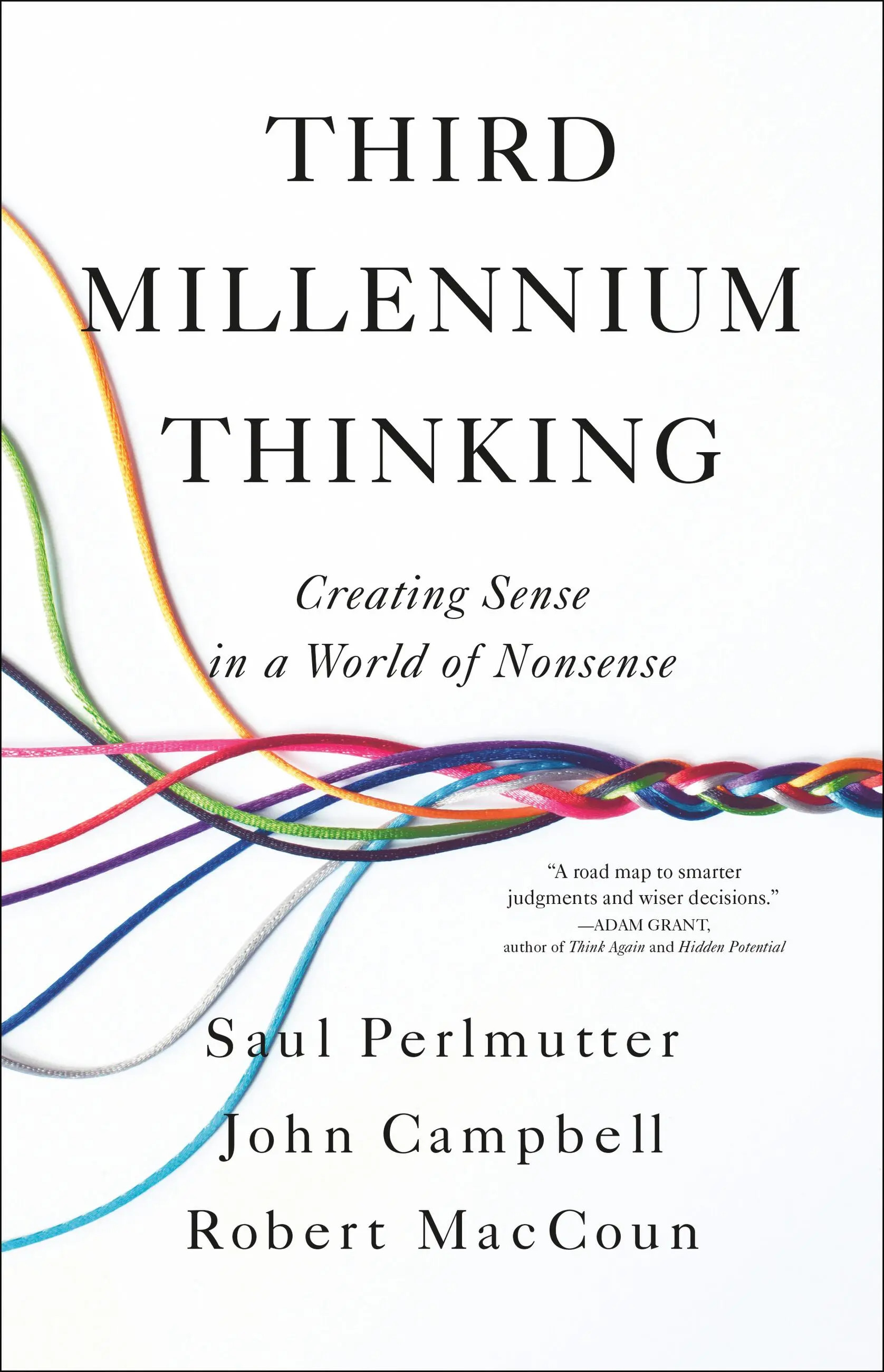
Saul began his graduate student research with that last project, the automated supernova search. Eventually that project led to an even more challenging one when it became clear that the same techniques could be used to find vastly more distant supernovae that could reveal the history of the universe’s expansion – and predict its eventual fate. This was going to be an immensely challenging project. Saul and his team estimated it would take three years to find the dozens of such distant supernovae they needed to find in order to measure changes in the universe’s expansion rate. Three years later, zero of these distant supernovae had been found. (Tip: When at all possible, avoid fields where your success depends on clear weather!) After five years, the first one was discovered. After seven years, the team had really figured out how to do the project, and they were finding distant supernovae in batches of half a dozen or so. Nine years in, they had the dataset in hand, but still hadn’t figured out how to analyze it at the level required. After ten years, they had an answer – and a big surprise: the universe’s expansion is accelerating.
Interestingly, at every stage of the ten-year supernova project, the team was pretty sure that the project was doable. Scientific optimism did keep them going – but it is important to see how this works in practice. At every step of the project, the team could see what successes had been accomplished and what was needed next to keep moving toward the goal. This iterative advancement is key to so much of this can‑do story; it’s not that the scientists are counting on accomplishing their goal in one fell swoop.
Making progress on hard problems, problems that can take months, years, or decades, usually requires such iterative advancement, meaning we do better and better with each attempt and build on what we learned in the previous attempts. As we unpack some of the practical implications of scientific optimism, this concept of iterative advancement is one that should resonate with all planners. To illustrate with just one example: policymakers and legislators drafting a major welfare reform bill or education improvement bill or crime reduction bill could – and should – build into it the assumption that it will need to be iteratively improved every few years as we learn what works and what doesn’t. Such policy-updating mechanisms are not unheard of, but they are certainly not a prominent, visible feature of our government programs, at least in the United States. Perhaps if they were, we would have more of a sense of the degree of progress on any of these societal goals.
Copyright information
Adapted from “THIRD MILLENNIUM THINKING” by Saul Perlmutter, John Campbell, and Robert MacCoun. Copyright ©️ 2024 by Saul Perlmutter, John Campbell, and Robert MacCoun. Used with permission of Little, Brown Spark, an imprint of Little, Brown and Company. New York, NY. All rights reserved.
Why there's a special education and STEM teacher shortage and what can be done
Experts say obstacles include recruitment, funding and institutional support.
Jahsha Tabron, the 2022 Delaware teacher of the year, taught special education for more than two decades and cherished what she called the "winning moments" of growth in her students.
"[Where] you have a nonverbal student who is now able to speak in simple sentences … that's why you stay," she recently told ABC News.
But Tabron, now Brandywine High School's dean of students in Wilmington, Delaware, said her field can be a tough sell for future candidates.
"When we're talking about why we don't have a lot of people joining the profession, we're looking at the immense workload that comes along with being a special education teacher," she said.
MORE: Most of the US is dealing with a teaching shortage, but the data isn't so simple
Tabron's concern about a staffing shortage is widely shared. A nationwide survey conducted by ABC News this school year found that much of the country doesn't have enough educators -- and that in many cases, districts suffer from a lack of subject matter experts, too.
Two parts of the subject matter pool are particularly strained, according to local education officials: special education and science, technology, engineering and mathematics, or STEM.
Teachers and experts who spoke with ABC News cited the need for more money for students with disabilities and those who educate them; inadequate diversity in STEM; and underwhelming pipeline and recruiting efforts, particularly in more rural districts and for teachers of color, as major obstacles.

Special education has always been one of the most underfunded yet vital teaching positions in public schools, the experts said -- pointing to a perpetual desire for more financial support, either at the local or federal level, to help instructors doing such specialized work.
The experts said that STEM teachers are overwhelmingly white -- according to the National Center for Education Statistics (NCES), 79% are non-Hispanic or white -- even in public schools that are majority non-white, so they do not adequately reflect the students they teach, which creates an added pressure on bringing in more candidates. There's also a focus on increasing diversity in special education instruction.
By the numbers
For a recent report on teacher staffing across the country, ABC News reached out by phone and email to the overarching education departments in all 50 states as well as Washington, D.C., Puerto Rico and the U.S. Virgin Islands.
At least 40 states, the District of Columbia and the U.S. Virgin Islands -- 42 out of 53 surveyed -- reported ongoing teaching shortages.
According to an updated analysis, conducted this spring, the most acute shortages are in special education and STEM teachers.
Those findings are reinforced by research from NCES' School Pulse Panel, which started collecting information during the summer of 2021 to better understand the impact of the COVID-19 pandemic on students and educators.

The monthly NCES survey found 78% of K-12 public school principals reported that it was somewhat or very "difficult" to fill a position with a fully certified teacher for special education at the beginning of the current school year. About three-fourths of public schools also reported it was somewhat or very difficult to staff physical science (78%) and mathematics (75%) teachers.
ABC News' reporting found that 31 state education associations, agencies and departments identified special education challenges as one of their greatest needs during the 2022-2023 school year.
MORE: How schools are trying to address the national teacher shortage
What's more, over the course of the school year, almost a third of the country -- or 17 state education agencies -- also told ABC News one of their greatest challenges has been filling teaching positions in STEM.
Education Secretary Miguel Cardona said in a speech last year that collaboration is the key to raising the bar for education across America. He also spoke of teacher shortages in bilingual education, special education and STEM -- saying they impact low-income and students of color the most.
'We have a real problem'
The federal government's Office of Special Education Programs (OSEP) recognizes that many states are facing staffing challenges and is committed to trying to fix the system as a whole, according to OSEP Director Valerie Williams.
"There's data to support that we have a real problem," Williams told ABC News. "Going forward, we're going to aim to focus not just on increasing the numbers but also on diversification of the profession and finding ways for how we can get people from minority backgrounds interested in becoming teachers and get them into the pipeline."

President Joe Biden's 2024 budget proposal -- which has been criticized by conservatives for, they say, reducing economic growth by bloating the government -- is touted by supporters as addressing the gap in special education teachers, "investing $304 million to train and retain [them], specialized instructional support personnel, and paraprofessionals," according to a Department of Education spokesperson.
A recent House Republican proposal to reduce federal government spending has been criticized, too, though conservatives have pushed back on claims it would cut school funding -- calling that made up.
Tabron, in Delaware, said special education is one of the most challenging positions in a school as it not only has general instruction responsibilities but also juggles needs and disciplines that most teachers don't face.
"It's not regular teaching," she said. "You have special ed teachers who are doing the regular part of teaching, which is the planning instruction, the differentiation, the accommodations and modifications. But in addition to just that part of your job as a special education teacher, you are also responsible for creating individualized education plans (IEP) for all of your students."
She described special education teachers as akin to scientists, because they're required to know how their students' brains work.
During the onset of COVID-19, many teachers' workloads were exacerbated by school closures and remote teaching, Tabron said. Now, she said, those who have stayed are working with the same amount of pre-pandemic resources -- but their role has expanded to account for a recent increase in students who see the value of IEPs and special services.
"There was a need for special education teachers before the pandemic," Tabron said. "The need just increased afterwards."
'Our country really needs to step it up'
Connecticut science teacher Carolyn Kielma is raising awareness around the challenges in STEM staffing, too. The self-described "STEMinist" said all it takes is for people to have a drive and passion for teaching.
"Our country really needs to step it up in those careers if we're going to have productive citizens in the future," the 2023 National Teacher of the Year finalist said. "All students are gifted and all students have special needs. It's our job to figure out what those gifts are and what those needs are and marry them into the best lesson plan."
Experts, though, have told ABC News the STEM shortage is a "crisis." They said not only is the field missing teachers but there's also a dearth of aspiring applicants.
"We don't have enough people [in general] going into STEM careers, and so the downstream effect of that is we don't have enough STEM teachers," said Arthur Mitchell, executive director of the STEM Equity Alliance.

Education advocates told ABC News that college graduates with education degrees have been declining for years. The University of California at Los Angeles' Cooperative Institutional Research Program found only 4.3% of U.S. college freshmen intended to major in education in 2018, compared to 11% in 2000.
Mitchell said the absence of young teachers is hurting STEM teaching categories. However, he believes there's a "neglect" problem in higher education and that institutions have to fully commit to recruitment and outreach.
"We're looking for those who have an interest in STEM education and nurturing that," said Mitchell, whose STEM Equity Alliance serves as a pipeline for teacher education. "And, by and large, there have been no concerted efforts -- national concerted efforts -- and very few statewide or local efforts to really put more STEM teachers in classrooms."
Another problem? Rural areas are underserved
Upon graduation many teachers are hesitant to explore rural parts of the U.S., according to education officials around the country.
Colorado's state education talent unit said that geographical barriers are straining their most rural, and already struggling, districts.
"Math and special education shortages can affect rural areas more acutely," Colorado's Associate Commissioner of Educator Talent Colleen O'Neil told ABC News in a statement. "[Rural parts] sometimes have no candidates at all that apply for a position," she added.
Along the Pacific coast, Siskiyou County's Allan Carver said his district also faces these roadblocks because it is in the "sticks" of Northern California.
"There's not a lot of people who want to live way out here where there's no Walmart and those sorts of things," said Carver, the Siskiyou Office of Education superintendent.
Working with a limited pool is something Southeast Arkansas Education Service Cooperative Director Karen Eoff understands as well as Carver.
According to the state's department of education, Arkansas faces its worst staffing shortages in secondary math and secondary science. But from elementary education on up, Eoff said all subjects in the rural parts of her state are impacted.
"Keeping and attracting young people to this area is a problem -- we have the largest teacher shortage in Arkansas," Eoff, who oversees 15 school districts, told ABC News.

More -- and more diverse -- pipeline programs needed
Experts interviewed for this story suggested pipeline programs could be the key to preparing teachers to enter the field in the years to come.
Reach University, a job-embedded teacher apprenticeship program, has been one solution for places like rural Arkansas and California, which are far from their state's largest institutions for training future educators.
In both Southeast Arkansas and in Siskiyou County in California, Reach University said it did an extensive analysis to define current vacancies by grade level and subject, across all open positions. In Siskiyou, they found slightly elevated vacancies in elementary education and math. Special education is "always" a constant need in his district, according to Carver.
"We've got to figure out how to take people who are already happy being in schools and help them become our teachers," Carver said. "The Reach model, with the apprenticeship, was just a home run for us."
Eoff's office has used Reach since the beginning of the current school year to stem its shortages. Now, she said, it has 20 paraprofessional staffers in an apprenticeship.
"Reach has been one of our best tools because of the support, affordability, the 'come alongside and we will help you' approach," Eoff said.
In response to former President Barack Obama's 2011 call to increase the STEM teacher pool by 100,000 in a decade, education nonprofit Beyond100K used "radical collaboration" with more than 300 organizations to exceed that benchmark. The group said it helped prepare 108,000 STEM teachers -- and counting -- with a new target of 150,000 by 2032.
Part of Beyond100K's focus, according to its 2022 trends report, is to add more teachers of color to reflect the students in their classrooms, especially Black, Latino and Native American teachers.
"The work that we are doing now is very focused on racial equity and on creating belonging for teachers and for students," Amber Hamilton, Beyond100K's chief external officer, said.
Eoff, in Arkansas, stressed how instilling that sense of belonging into students of all ages and backgrounds will hopefully guide more candidates to the field.
"I think that the earlier we encourage kids to believe they can, in STEM programs, the better," she said.
Meanwhile, as responsibilities from the pandemic grow, STEM and special education professionals agree the shortages will persist if more isn't done to help them win.
"I think that would be awesome to ask teachers what they really need," Tabron said. "Imagine someone asking you: What would make you happier here? What can I do to support you? Just you listening to that -- I think would change my performance."
ABC News' Gabe Ferris contributed to this report.
Trending Reader Picks

Trump Jr. visited Peter Navarro in prison: Sources
- May 13, 11:45 AM

Police find suspect in fatal shooting dead
- May 12, 8:48 PM

Teen graduates with doctoral degree
- 41 minutes ago

Harry returns to London, will not visit Charles
- May 8, 1:26 PM

Legal experts on SCOTUS and Trump immunity case
- Apr 30, 6:52 AM
ABC News Live
24/7 coverage of breaking news and live events
- Grades 6-12
- School Leaders
Free end-of-year letter templates to your students 📝!
72 Easy Science Experiments Using Materials You Already Have On Hand
Because science doesn’t have to be complicated.
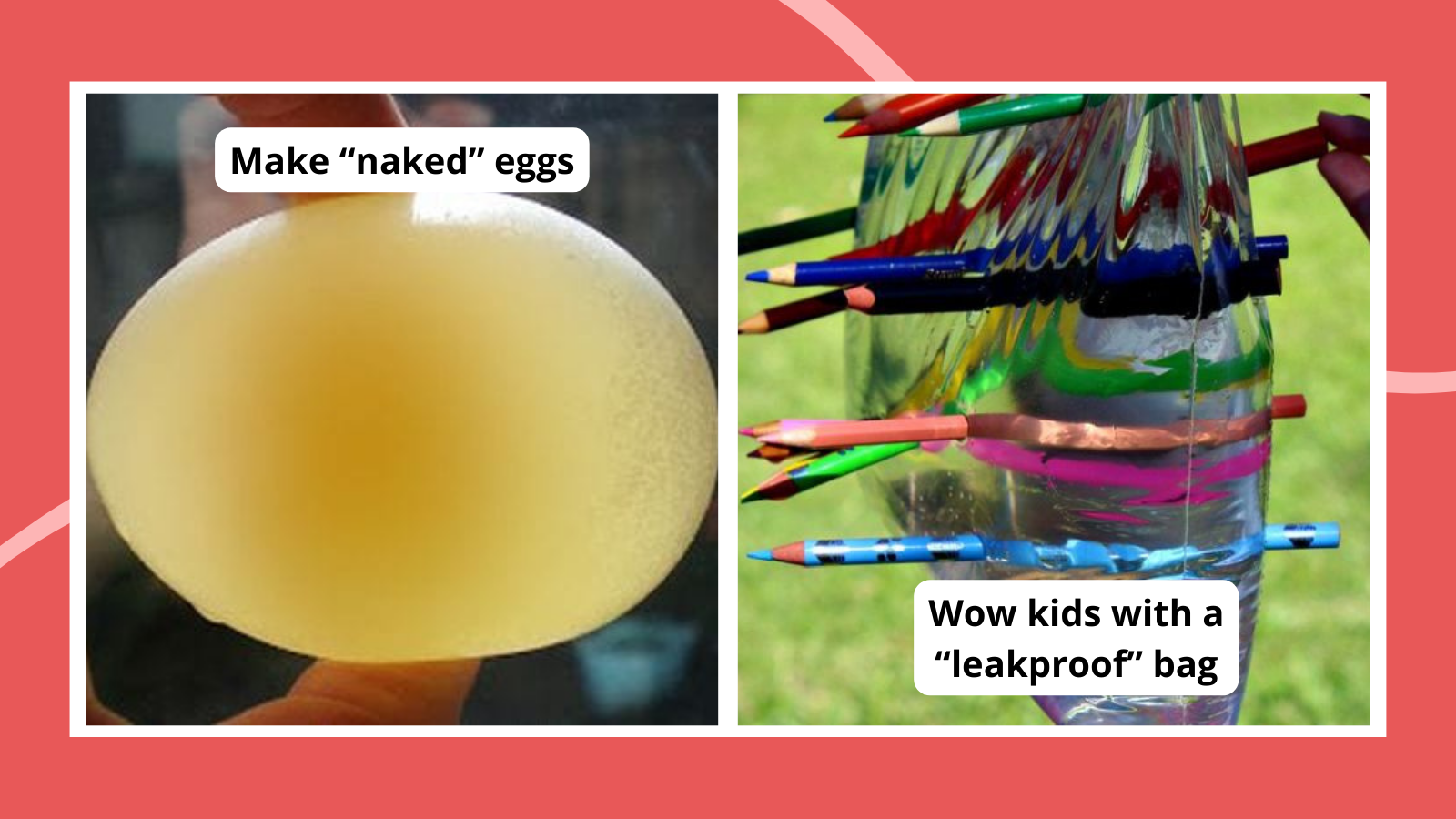
If there is one thing that is guaranteed to get your students excited, it’s a good science experiment! While some experiments require expensive lab equipment or dangerous chemicals, there are plenty of cool projects you can do with regular household items. We’ve rounded up a big collection of easy science experiments that anybody can try, and kids are going to love them!
Easy Chemistry Science Experiments
Easy physics science experiments, easy biology and environmental science experiments, easy engineering experiments and stem challenges.

1. Taste the Rainbow
Teach your students about diffusion while creating a beautiful and tasty rainbow! Tip: Have extra Skittles on hand so your class can eat a few!
Learn more: Skittles Diffusion

2. Crystallize sweet treats
Crystal science experiments teach kids about supersaturated solutions. This one is easy to do at home, and the results are absolutely delicious!
Learn more: Candy Crystals
3. Make a volcano erupt
This classic experiment demonstrates a chemical reaction between baking soda (sodium bicarbonate) and vinegar (acetic acid), which produces carbon dioxide gas, water, and sodium acetate.
Learn more: Best Volcano Experiments
4. Make elephant toothpaste
This fun project uses yeast and a hydrogen peroxide solution to create overflowing “elephant toothpaste.” Tip: Add an extra fun layer by having kids create toothpaste wrappers for plastic bottles.
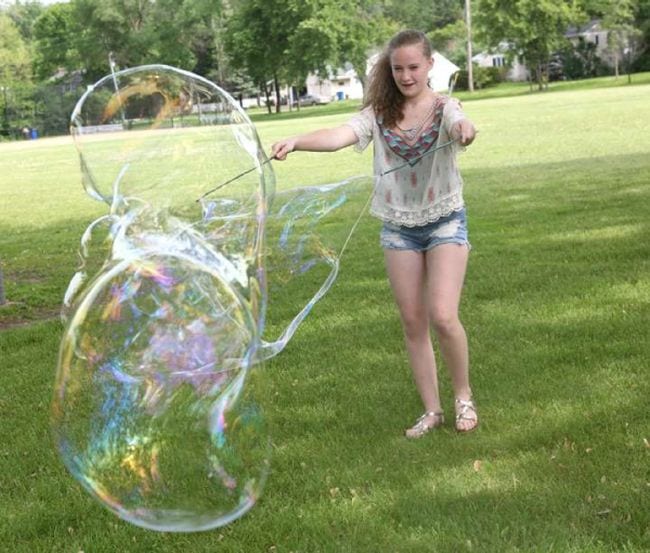
5. Blow the biggest bubbles you can
Add a few simple ingredients to dish soap solution to create the largest bubbles you’ve ever seen! Kids learn about surface tension as they engineer these bubble-blowing wands.
Learn more: Giant Soap Bubbles
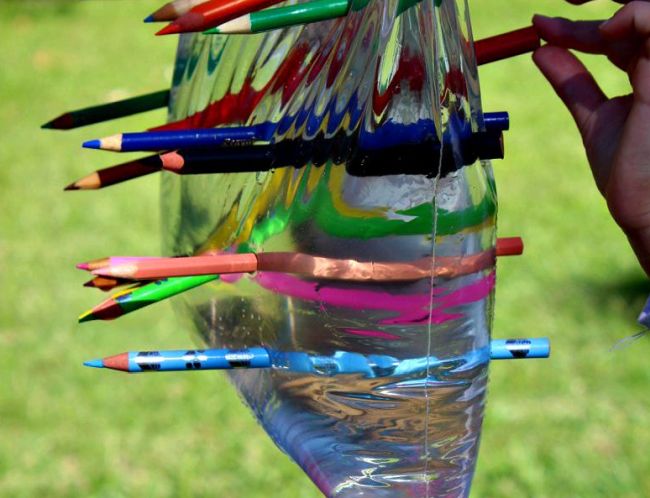
6. Demonstrate the “magic” leakproof bag
All you need is a zip-top plastic bag, sharp pencils, and water to blow your kids’ minds. Once they’re suitably impressed, teach them how the “trick” works by explaining the chemistry of polymers.
Learn more: Leakproof Bag

7. Use apple slices to learn about oxidation
Have students make predictions about what will happen to apple slices when immersed in different liquids, then put those predictions to the test. Have them record their observations.
Learn more: Apple Oxidation
8. Float a marker man
Their eyes will pop out of their heads when you “levitate” a stick figure right off the table! This experiment works due to the insolubility of dry-erase marker ink in water, combined with the lighter density of the ink.
Learn more: Floating Marker Man

9. Discover density with hot and cold water
There are a lot of easy science experiments you can do with density. This one is extremely simple, involving only hot and cold water and food coloring, but the visuals make it appealing and fun.
Learn more: Layered Water

10. Layer more liquids
This density demo is a little more complicated, but the effects are spectacular. Slowly layer liquids like honey, dish soap, water, and rubbing alcohol in a glass. Kids will be amazed when the liquids float one on top of the other like magic (except it is really science).
Learn more: Layered Liquids
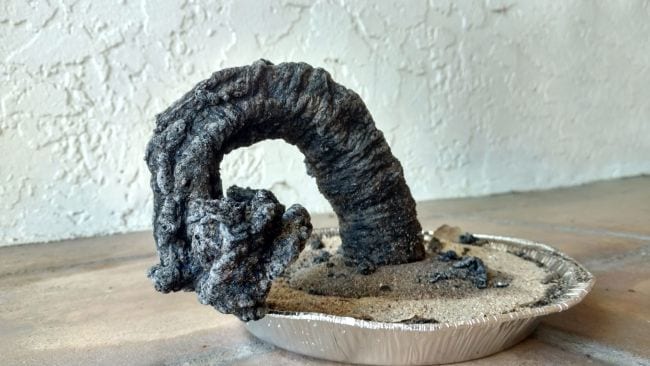
11. Grow a carbon sugar snake
Easy science experiments can still have impressive results! This eye-popping chemical reaction demonstration only requires simple supplies like sugar, baking soda, and sand.
Learn more: Carbon Sugar Snake
12. Mix up some slime
Tell kids you’re going to make slime at home, and watch their eyes light up! There are a variety of ways to make slime, so try a few different recipes to find the one you like best.
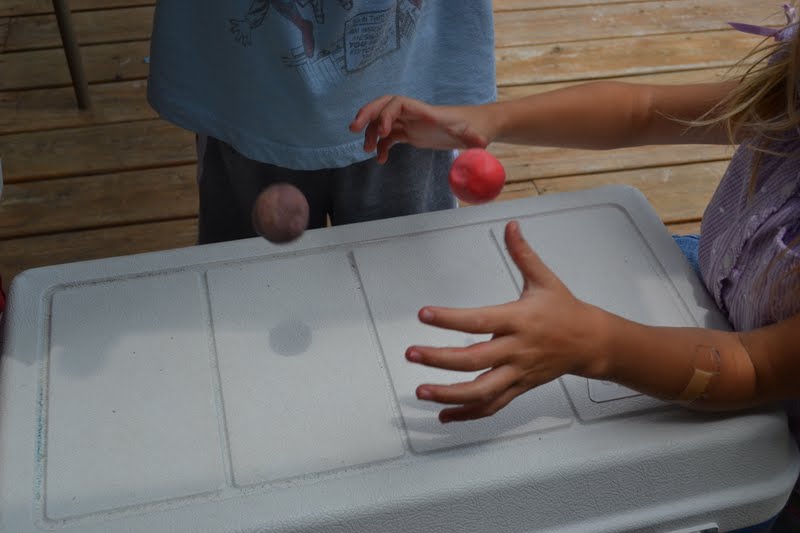
13. Make homemade bouncy balls
These homemade bouncy balls are easy to make since all you need is glue, food coloring, borax powder, cornstarch, and warm water. You’ll want to store them inside a container like a plastic egg because they will flatten out over time.
Learn more: Make Your Own Bouncy Balls

14. Create eggshell chalk
Eggshells contain calcium, the same material that makes chalk. Grind them up and mix them with flour, water, and food coloring to make your very own sidewalk chalk.
Learn more: Eggshell Chalk

15. Make naked eggs
This is so cool! Use vinegar to dissolve the calcium carbonate in an eggshell to discover the membrane underneath that holds the egg together. Then, use the “naked” egg for another easy science experiment that demonstrates osmosis .
Learn more: Naked Egg Experiment
16. Turn milk into plastic
This sounds a lot more complicated than it is, but don’t be afraid to give it a try. Use simple kitchen supplies to create plastic polymers from plain old milk. Sculpt them into cool shapes when you’re done!
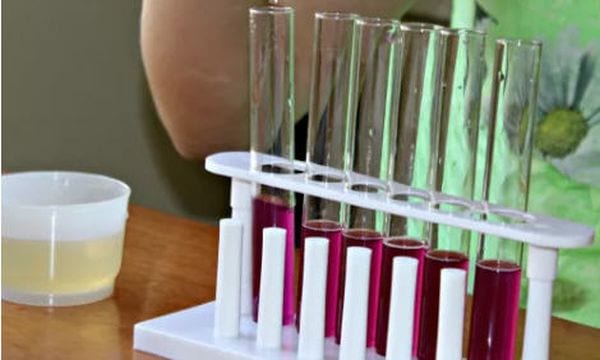
17. Test pH using cabbage
Teach kids about acids and bases without needing pH test strips! Simply boil some red cabbage and use the resulting water to test various substances—acids turn red and bases turn green.
Learn more: Cabbage pH
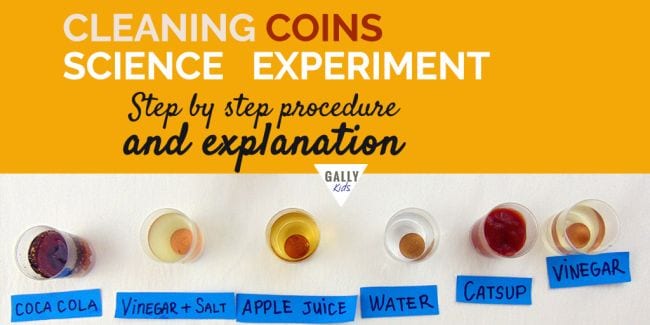
18. Clean some old coins
Use common household items to make old oxidized coins clean and shiny again in this simple chemistry experiment. Ask kids to predict (hypothesize) which will work best, then expand the learning by doing some research to explain the results.
Learn more: Cleaning Coins

19. Pull an egg into a bottle
This classic easy science experiment never fails to delight. Use the power of air pressure to suck a hard-boiled egg into a jar, no hands required.
Learn more: Egg in a Bottle

20. Blow up a balloon (without blowing)
Chances are good you probably did easy science experiments like this when you were in school. The baking soda and vinegar balloon experiment demonstrates the reactions between acids and bases when you fill a bottle with vinegar and a balloon with baking soda.
21 Assemble a DIY lava lamp
This 1970s trend is back—as an easy science experiment! This activity combines acid-base reactions with density for a totally groovy result.

22. Explore how sugary drinks affect teeth
The calcium content of eggshells makes them a great stand-in for teeth. Use eggs to explore how soda and juice can stain teeth and wear down the enamel. Expand your learning by trying different toothpaste-and-toothbrush combinations to see how effective they are.
Learn more: Sugar and Teeth Experiment
23. Mummify a hot dog
If your kids are fascinated by the Egyptians, they’ll love learning to mummify a hot dog! No need for canopic jars , just grab some baking soda and get started.
24. Extinguish flames with carbon dioxide
This is a fiery twist on acid-base experiments. Light a candle and talk about what fire needs in order to survive. Then, create an acid-base reaction and “pour” the carbon dioxide to extinguish the flame. The CO2 gas acts like a liquid, suffocating the fire.

25. Send secret messages with invisible ink
Turn your kids into secret agents! Write messages with a paintbrush dipped in lemon juice, then hold the paper over a heat source and watch the invisible become visible as oxidation goes to work.
Learn more: Invisible Ink
26. Create dancing popcorn
This is a fun version of the classic baking soda and vinegar experiment, perfect for the younger crowd. The bubbly mixture causes popcorn to dance around in the water.
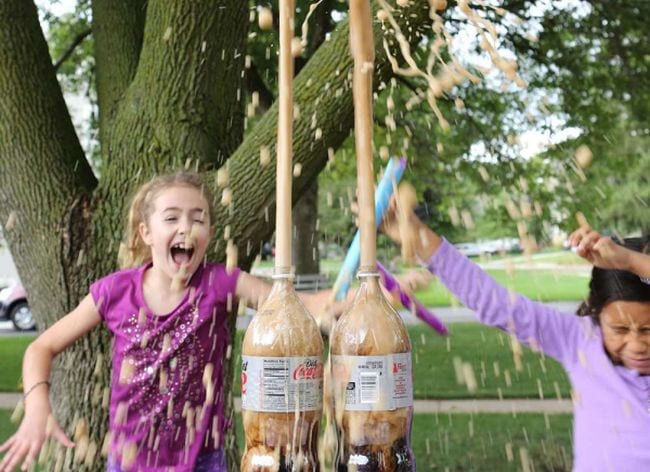
27. Shoot a soda geyser sky-high
You’ve always wondered if this really works, so it’s time to find out for yourself! Kids will marvel at the chemical reaction that sends diet soda shooting high in the air when Mentos are added.
Learn more: Soda Explosion

28. Send a teabag flying
Hot air rises, and this experiment can prove it! You’ll want to supervise kids with fire, of course. For more safety, try this one outside.
Learn more: Flying Tea Bags
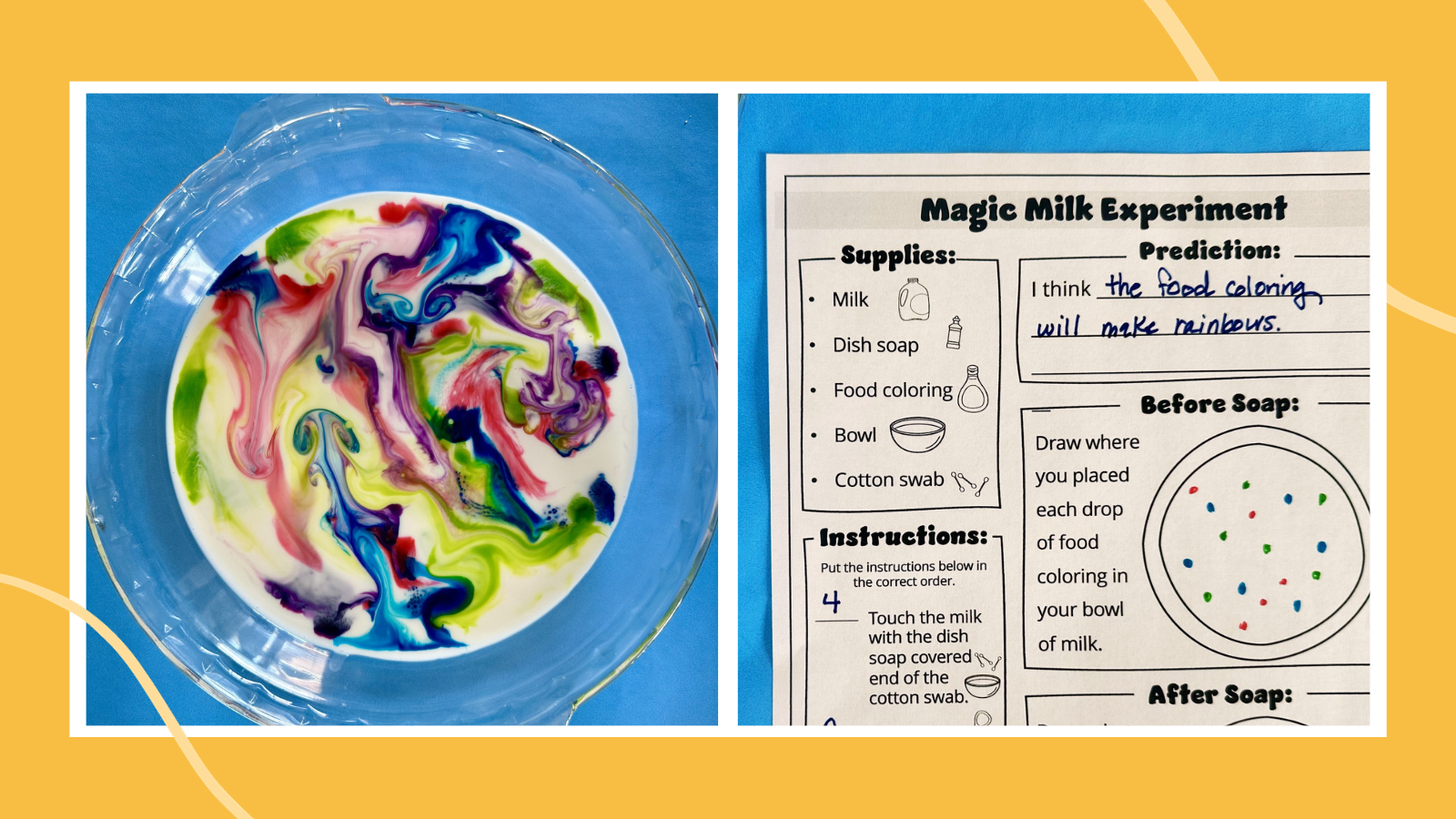
29. Create magic milk
This fun and easy science experiment demonstrates principles related to surface tension, molecular interactions, and fluid dynamics.
Learn more: Magic Milk Experiment
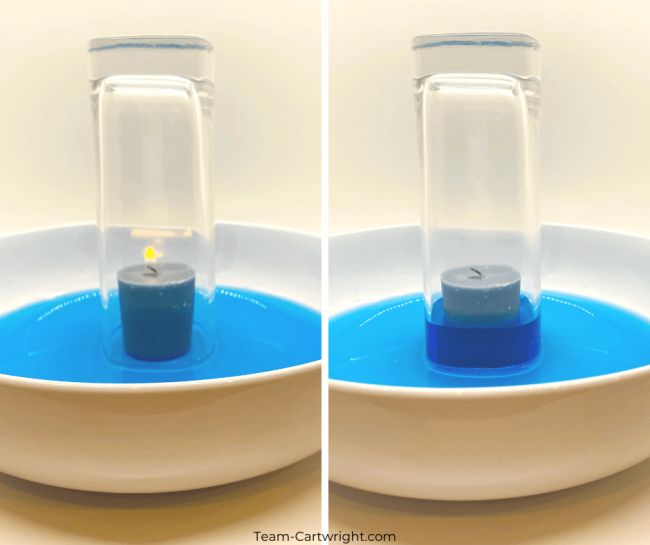
30. Watch the water rise
Learn about Charles’s Law with this simple experiment. As the candle burns, using up oxygen and heating the air in the glass, the water rises as if by magic.
Learn more: Rising Water
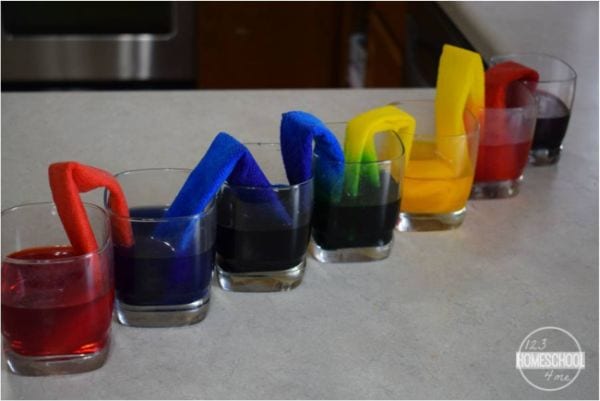
31. Learn about capillary action
Kids will be amazed as they watch the colored water move from glass to glass, and you’ll love the easy and inexpensive setup. Gather some water, paper towels, and food coloring to teach the scientific magic of capillary action.
Learn more: Capillary Action
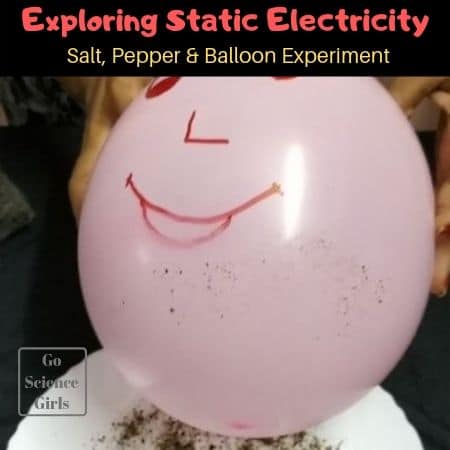
32. Give a balloon a beard
Equally educational and fun, this experiment will teach kids about static electricity using everyday materials. Kids will undoubtedly get a kick out of creating beards on their balloon person!
Learn more: Static Electricity

33. Find your way with a DIY compass
Here’s an old classic that never fails to impress. Magnetize a needle, float it on the water’s surface, and it will always point north.
Learn more: DIY Compass
34. Crush a can using air pressure
Sure, it’s easy to crush a soda can with your bare hands, but what if you could do it without touching it at all? That’s the power of air pressure!

35. Tell time using the sun
While people use clocks or even phones to tell time today, there was a time when a sundial was the best means to do that. Kids will certainly get a kick out of creating their own sundials using everyday materials like cardboard and pencils.
Learn more: Make Your Own Sundial
36. Launch a balloon rocket
Grab balloons, string, straws, and tape, and launch rockets to learn about the laws of motion.
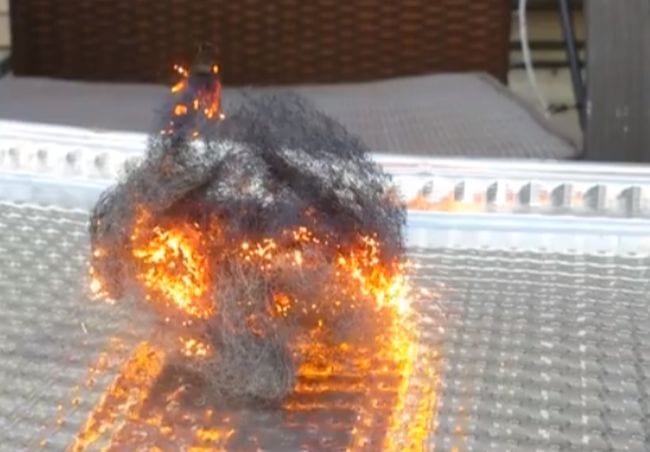
37. Make sparks with steel wool
All you need is steel wool and a 9-volt battery to perform this science demo that’s bound to make their eyes light up! Kids learn about chain reactions, chemical changes, and more.
Learn more: Steel Wool Electricity
38. Levitate a Ping-Pong ball
Kids will get a kick out of this experiment, which is really all about Bernoulli’s principle. You only need plastic bottles, bendy straws, and Ping-Pong balls to make the science magic happen.
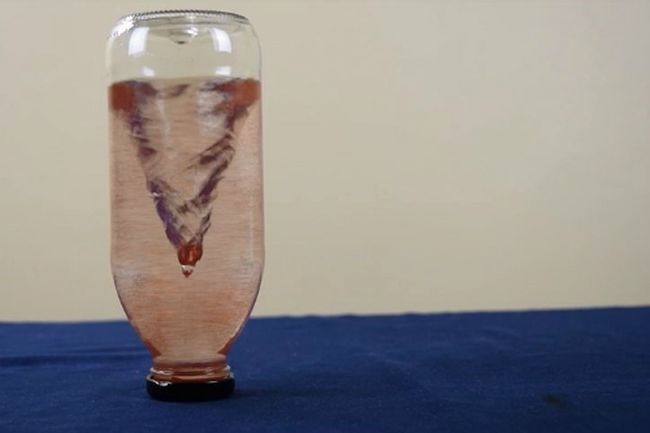
39. Whip up a tornado in a bottle
There are plenty of versions of this classic experiment out there, but we love this one because it sparkles! Kids learn about a vortex and what it takes to create one.
Learn more: Tornado in a Bottle
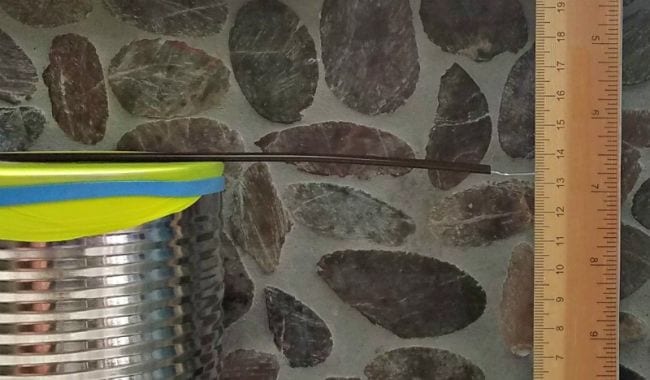
40. Monitor air pressure with a DIY barometer
This simple but effective DIY science project teaches kids about air pressure and meteorology. They’ll have fun tracking and predicting the weather with their very own barometer.
Learn more: DIY Barometer
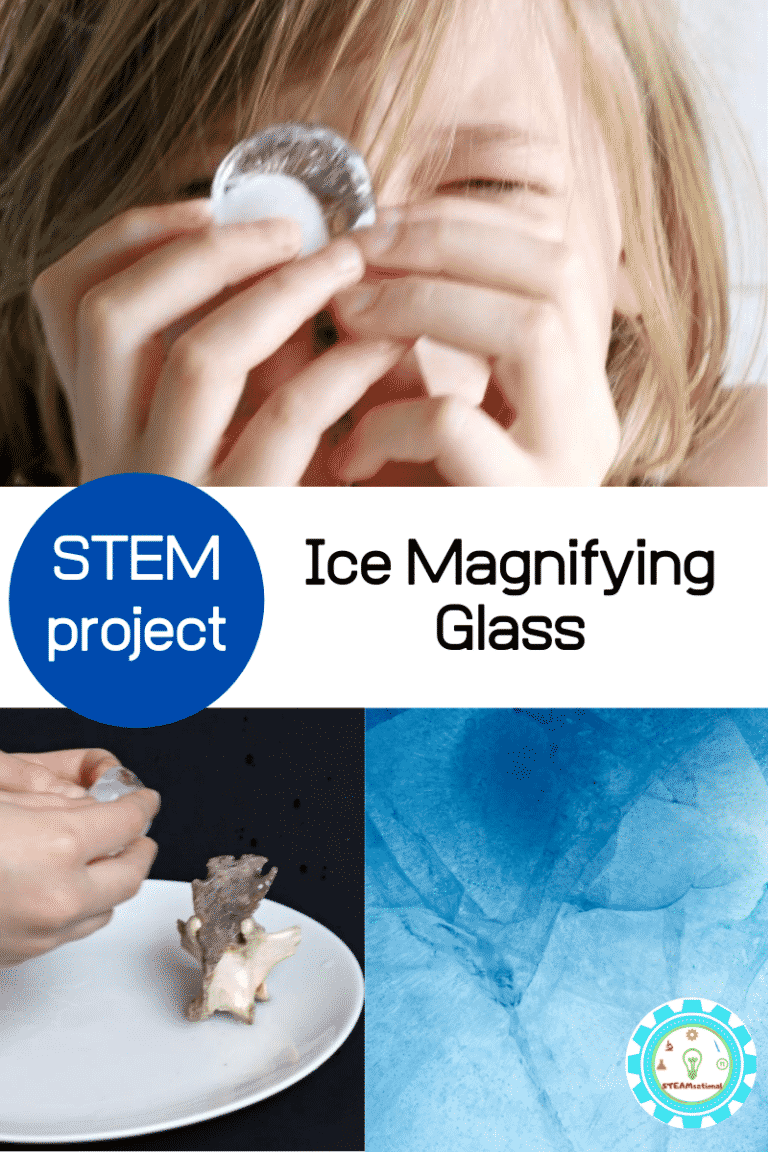
41. Peer through an ice magnifying glass
Students will certainly get a thrill out of seeing how an everyday object like a piece of ice can be used as a magnifying glass. Be sure to use purified or distilled water since tap water will have impurities in it that will cause distortion.
Learn more: Ice Magnifying Glass

42. String up some sticky ice
Can you lift an ice cube using just a piece of string? This quick experiment teaches you how. Use a little salt to melt the ice and then refreeze the ice with the string attached.
Learn more: Sticky Ice
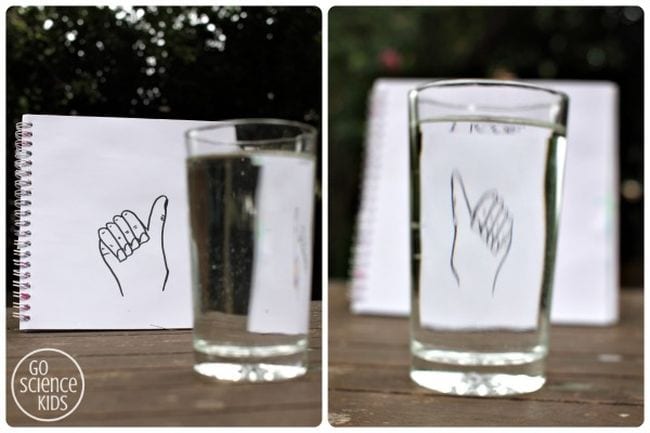
43. “Flip” a drawing with water
Light refraction causes some really cool effects, and there are multiple easy science experiments you can do with it. This one uses refraction to “flip” a drawing; you can also try the famous “disappearing penny” trick .
Learn more: Light Refraction With Water
44. Color some flowers
We love how simple this project is to re-create since all you’ll need are some white carnations, food coloring, glasses, and water. The end result is just so beautiful!
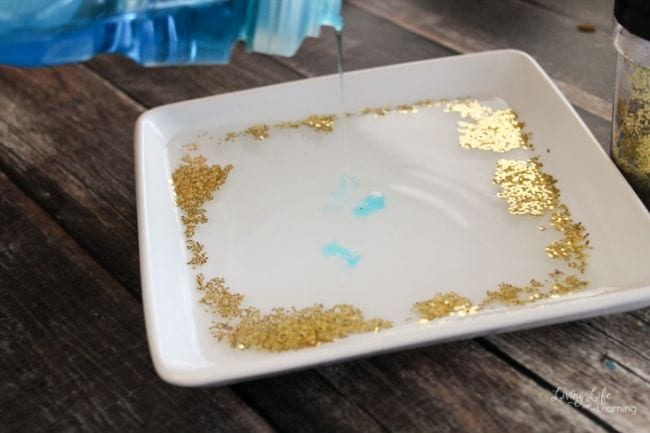
45. Use glitter to fight germs
Everyone knows that glitter is just like germs—it gets everywhere and is so hard to get rid of! Use that to your advantage and show kids how soap fights glitter and germs.
Learn more: Glitter Germs
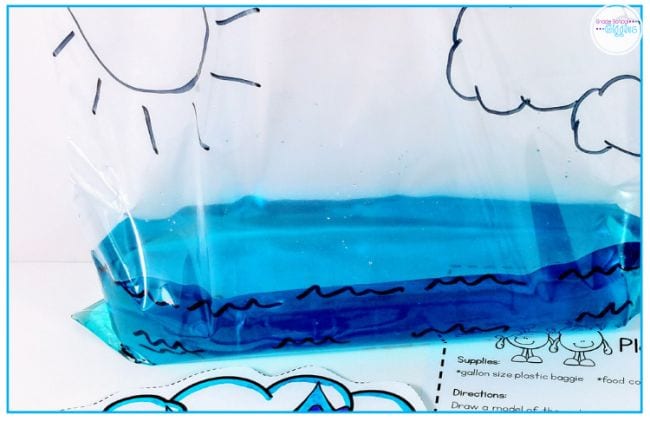
46. Re-create the water cycle in a bag
You can do so many easy science experiments with a simple zip-top bag. Fill one partway with water and set it on a sunny windowsill to see how the water evaporates up and eventually “rains” down.
Learn more: Water Cycle
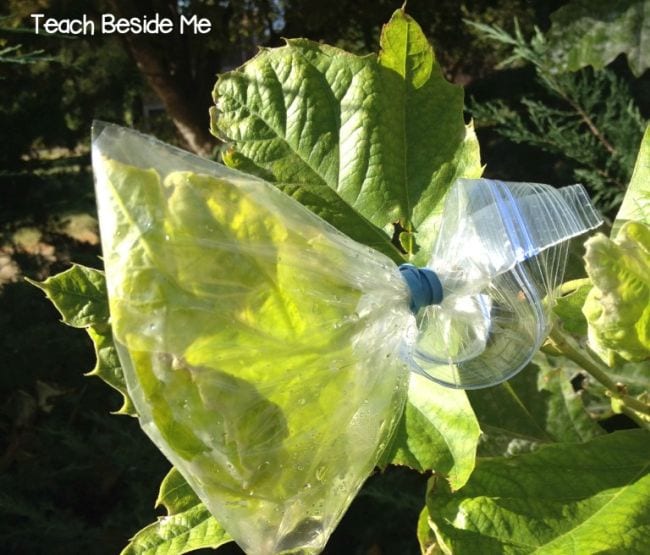
47. Learn about plant transpiration
Your backyard is a terrific place for easy science experiments. Grab a plastic bag and rubber band to learn how plants get rid of excess water they don’t need, a process known as transpiration.
Learn more: Plant Transpiration
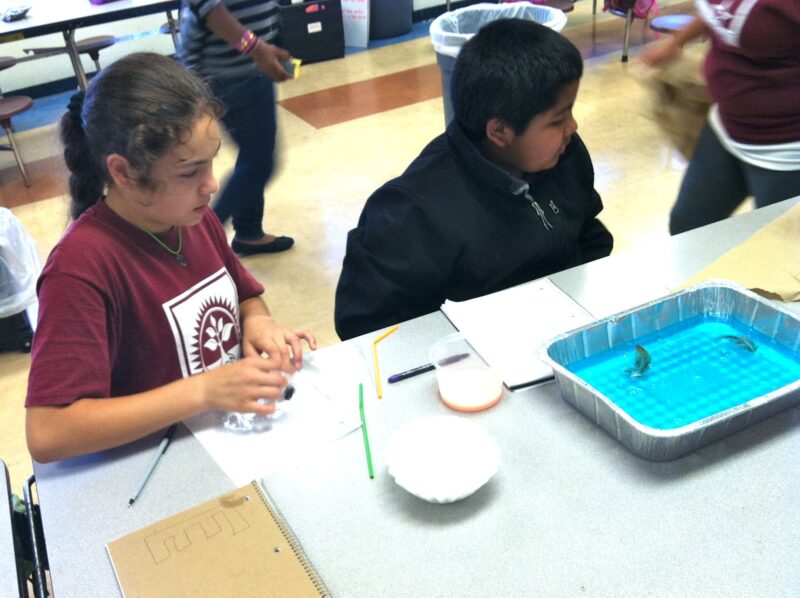
48. Clean up an oil spill
Before conducting this experiment, teach your students about engineers who solve environmental problems like oil spills. Then, have your students use provided materials to clean the oil spill from their oceans.
Learn more: Oil Spill
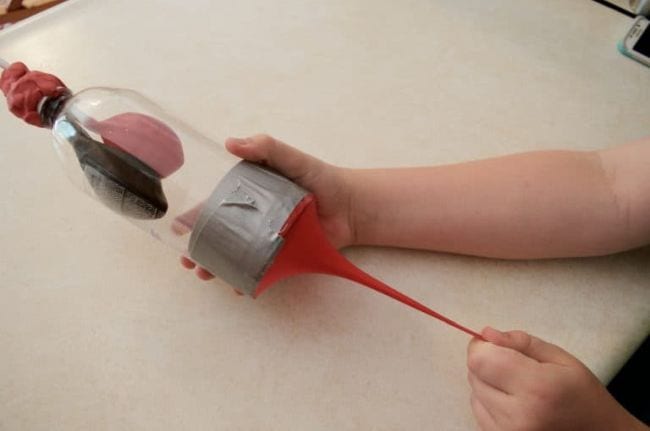
49. Construct a pair of model lungs
Kids get a better understanding of the respiratory system when they build model lungs using a plastic water bottle and some balloons. You can modify the experiment to demonstrate the effects of smoking too.
Learn more: Model Lungs

50. Experiment with limestone rocks
Kids love to collect rocks, and there are plenty of easy science experiments you can do with them. In this one, pour vinegar over a rock to see if it bubbles. If it does, you’ve found limestone!
Learn more: Limestone Experiments
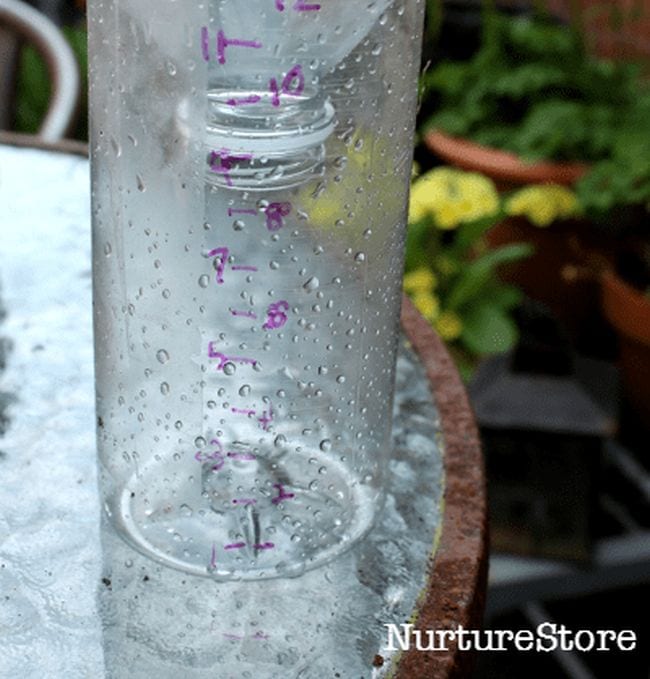
51. Turn a bottle into a rain gauge
All you need is a plastic bottle, a ruler, and a permanent marker to make your own rain gauge. Monitor your measurements and see how they stack up against meteorology reports in your area.
Learn more: DIY Rain Gauge

52. Build up towel mountains
This clever demonstration helps kids understand how some landforms are created. Use layers of towels to represent rock layers and boxes for continents. Then pu-u-u-sh and see what happens!
Learn more: Towel Mountains
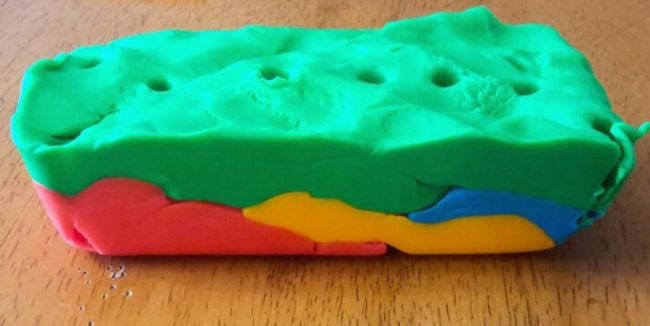
53. Take a play dough core sample
Learn about the layers of the earth by building them out of Play-Doh, then take a core sample with a straw. ( Love Play-Doh? Get more learning ideas here. )
Learn more: Play Dough Core Sampling
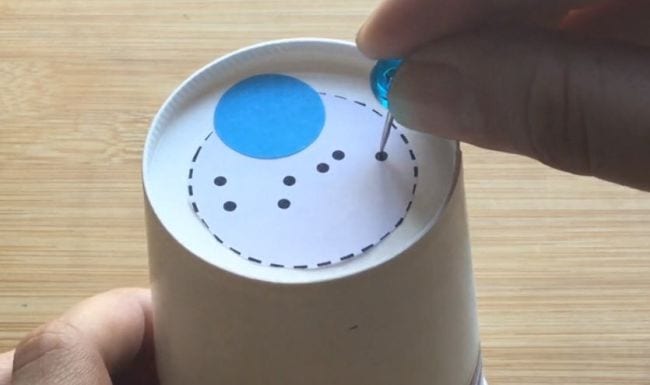
54. Project the stars on your ceiling
Use the video lesson in the link below to learn why stars are only visible at night. Then create a DIY star projector to explore the concept hands-on.
Learn more: DIY Star Projector

55. Make it rain
Use shaving cream and food coloring to simulate clouds and rain. This is an easy science experiment little ones will beg to do over and over.
Learn more: Shaving Cream Rain
56. Blow up your fingerprint
This is such a cool (and easy!) way to look at fingerprint patterns. Inflate a balloon a bit, use some ink to put a fingerprint on it, then blow it up big to see your fingerprint in detail.

57. Snack on a DNA model
Twizzlers, gumdrops, and a few toothpicks are all you need to make this super-fun (and yummy!) DNA model.
Learn more: Edible DNA Model
58. Dissect a flower
Take a nature walk and find a flower or two. Then bring them home and take them apart to discover all the different parts of flowers.

59. Craft smartphone speakers
No Bluetooth speaker? No problem! Put together your own from paper cups and toilet paper tubes.
Learn more: Smartphone Speakers
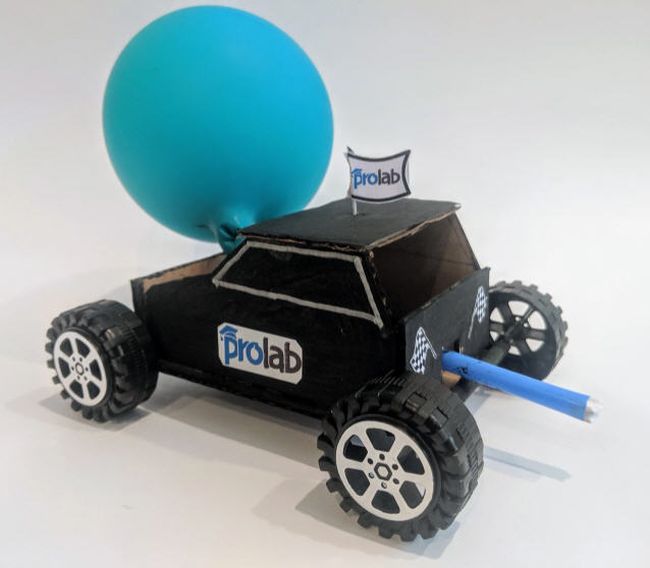
60. Race a balloon-powered car
Kids will be amazed when they learn they can put together this awesome racer using cardboard and bottle-cap wheels. The balloon-powered “engine” is so much fun too.
Learn more: Balloon-Powered Car
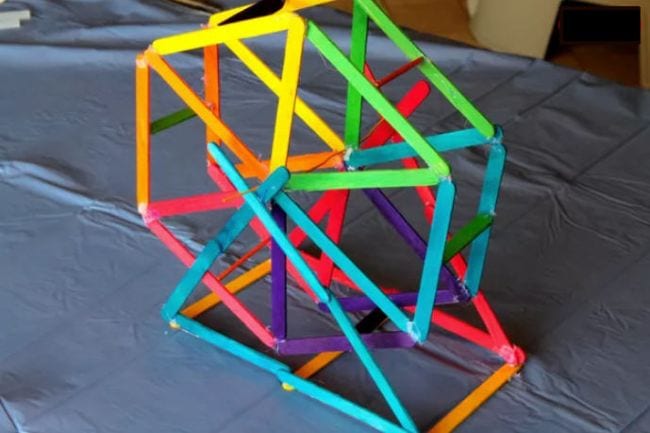
61. Build a Ferris wheel
You’ve probably ridden on a Ferris wheel, but can you build one? Stock up on wood craft sticks and find out! Play around with different designs to see which one works best.
Learn more: Craft Stick Ferris Wheel
62. Design a phone stand
There are lots of ways to craft a DIY phone stand, which makes this a perfect creative-thinking STEM challenge.
63. Conduct an egg drop
Put all their engineering skills to the test with an egg drop! Challenge kids to build a container from stuff they find around the house that will protect an egg from a long fall (this is especially fun to do from upper-story windows).
Learn more: Egg Drop Challenge Ideas
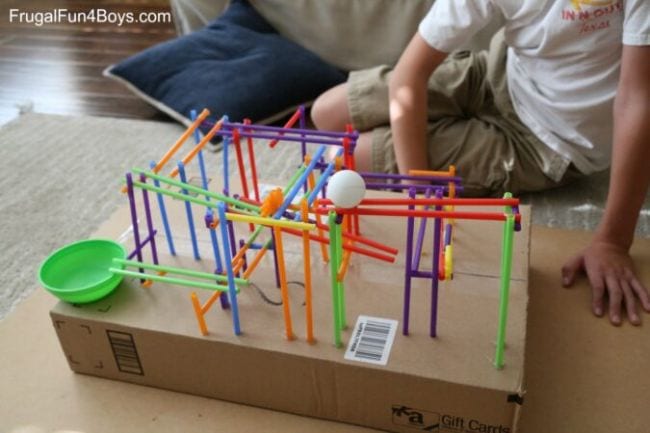
64. Engineer a drinking-straw roller coaster
STEM challenges are always a hit with kids. We love this one, which only requires basic supplies like drinking straws.
Learn more: Straw Roller Coaster
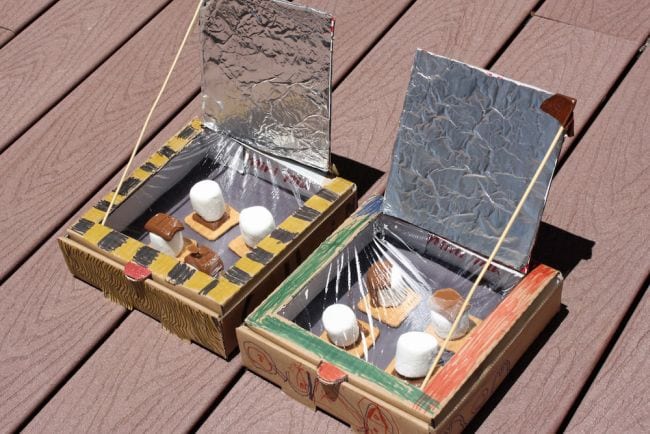
65. Build a solar oven
Explore the power of the sun when you build your own solar ovens and use them to cook some yummy treats. This experiment takes a little more time and effort, but the results are always impressive. The link below has complete instructions.
Learn more: Solar Oven
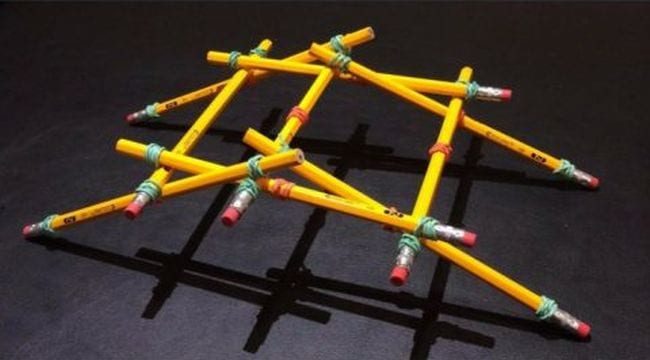
66. Build a Da Vinci bridge
There are plenty of bridge-building experiments out there, but this one is unique. It’s inspired by Leonardo da Vinci’s 500-year-old self-supporting wooden bridge. Learn how to build it at the link, and expand your learning by exploring more about Da Vinci himself.
Learn more: Da Vinci Bridge
67. Step through an index card
This is one easy science experiment that never fails to astonish. With carefully placed scissor cuts on an index card, you can make a loop large enough to fit a (small) human body through! Kids will be wowed as they learn about surface area.
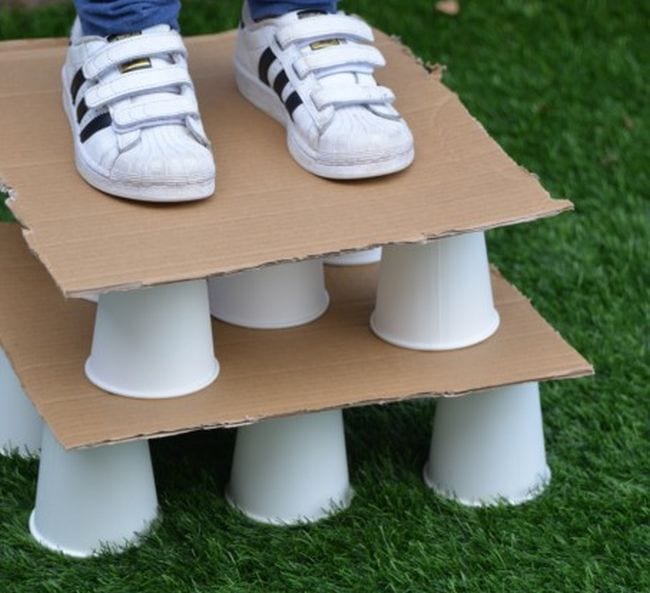
68. Stand on a pile of paper cups
Combine physics and engineering and challenge kids to create a paper cup structure that can support their weight. This is a cool project for aspiring architects.
Learn more: Paper Cup Stack
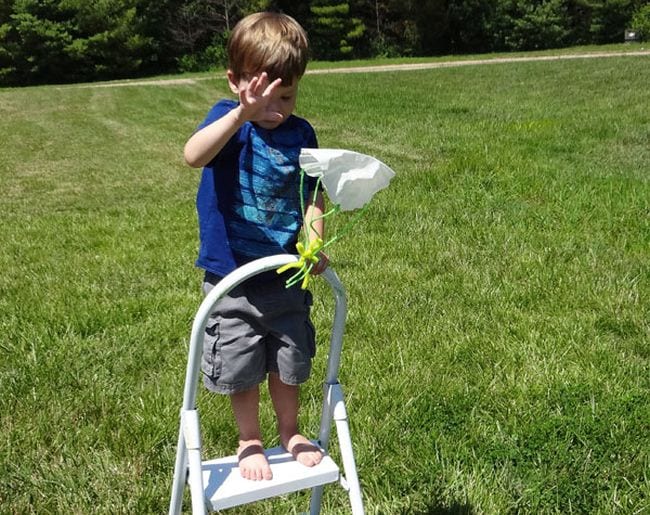
69. Test out parachutes
Gather a variety of materials (try tissues, handkerchiefs, plastic bags, etc.) and see which ones make the best parachutes. You can also find out how they’re affected by windy days or find out which ones work in the rain.
Learn more: Parachute Drop

70. Recycle newspapers into an engineering challenge
It’s amazing how a stack of newspapers can spark such creative engineering. Challenge kids to build a tower, support a book, or even build a chair using only newspaper and tape!
Learn more: Newspaper STEM Challenge

71. Use rubber bands to sound out acoustics
Explore the ways that sound waves are affected by what’s around them using a simple rubber band “guitar.” (Kids absolutely love playing with these!)
Learn more: Rubber Band Guitar
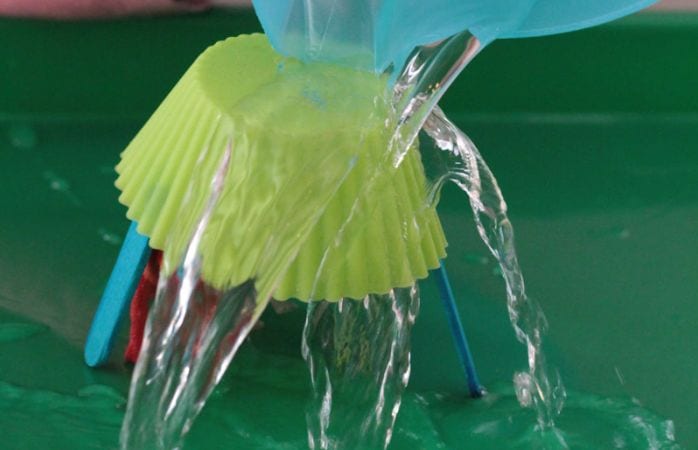
72. Assemble a better umbrella
Challenge students to engineer the best possible umbrella from various household supplies. Encourage them to plan, draw blueprints, and test their creations using the scientific method.
Learn more: Umbrella STEM Challenge
Plus, sign up for our newsletters to get all the latest learning ideas straight to your inbox.

You Might Also Like
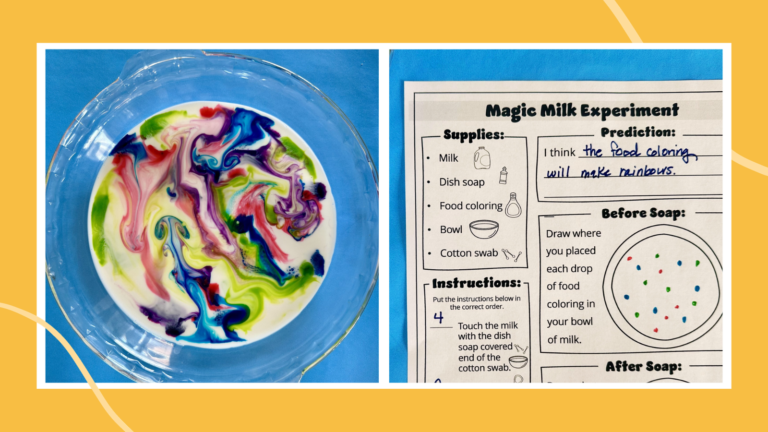
Magic Milk Experiment: How-To Plus Free Worksheet
This classic experiment teaches kids about basic chemistry and physics. Continue Reading
Copyright © 2024. All rights reserved. 5335 Gate Parkway, Jacksonville, FL 32256
- Open access
- Published: 10 May 2024
Challenges and opportunities of English as the medium of instruction in diploma midwifery programs in Bangladesh: a mixed-methods study
- Anna Williams 1 ,
- Jennifer R. Stevens 2 ,
- Rondi Anderson 3 &
- Malin Bogren 4
BMC Medical Education volume 24 , Article number: 523 ( 2024 ) Cite this article
111 Accesses
Metrics details
English is generally recognized as the international language of science and most research on evidence-based medicine is produced in English. While Bangla is the dominant language in Bangladesh, public midwifery degree programs use English as the medium of instruction (EMI). This enables faculty and student access to the latest evidence-based midwifery content, which is essential for provision of quality care later. Yet, it also poses a barrier, as limited English mastery among students and faculty limits both teaching and learning.
This mixed-methods study investigates the challenges and opportunities associated with the implementation of EMI in the context of diploma midwifery education in Bangladesh. Surveys were sent to principals at 38 public midwifery education institutions, and 14 English instructors at those schools. Additionally, ten key informant interviews were held with select knowledgeable stakeholders with key themes identified.
Surveys found that English instructors are primarily guest lecturers, trained in general or business English, without a standardized curriculum or functional English language laboratories. Three themes were identified in the key informant interviews. First, in addition to students’ challenges with English, faculty mastery of English presented challenges as well. Second, language labs were poorly maintained, often non-functional, and lacked faculty. Third, an alternative education model, such as the English for Specific Purposes (ESP) curriculum, has potential to strengthen English competencies within midwifery schools.
Conclusions
ESP, which teaches English for application in a specific discipline, is one option available in Bangladesh for midwifery education. Native language instruction and the middle ground of multilingualism are also useful options. Although a major undertaking, investing in an ESP model and translation of technical midwifery content into relevant mother tongues may provide faster and more complete learning. In addition, a tiered system of requirements for English competencies tied to higher levels of midwifery education could build bridges to students to help them access global evidence-based care resources. Higher levels might emphasize English more heavily, while the diploma level would follow a multilingualism approach, teach using an ESP curriculum, and have complementary emphasis on the mother tongue.
Peer Review reports
Introduction
As the international language of science, English holds an important position in the education of healthcare professionals. Globally, most scientific papers are published in English. In many non-native English-speaking countries, English is used as the language of instruction in higher education [ 1 ]. The dominant status held by the English language in the sciences is largely considered to increase global access to scientific information by unifying the scientific community under a single lingua franca [ 2 ].
In Bangladesh, where the mother tongue is Bangla and midwifery diploma programs are taught in English, knowledge of English facilitates student and instructor access to global, continuously updated evidence-based practice guidance. This includes basic and scientific texts, media-based instructional materials (including on life-saving skills), professional journals, and proceedings of medical conferences. Many of these resources are available for free online, which can be particularly useful in healthcare settings that have not integrated evidence-based practice.
In addition to opportunity though, English instruction also creates several challenges. Weak student and faculty English competency may impede midwifery education quality in Bangladesh. Globally, literature has linked limited instructor competency in the language of instruction with reduced depth, nuance, and accuracy in conveying subject matter content [ 3 ]. This can lead to the perpetuation of patterns of care in misalignment with global evidence. In addition, students’ native language proficiency in their topic of study can decline when instruction is in English, limiting native language communication between colleagues on the job later on [ 4 , 5 ].
In this paper, we examine the current status of English language instruction within public diploma midwifery programs in Bangladesh. Midwifery students are not required to demonstrate a certain skill level in English to enter the program. However, they are provided with English classes in the program. Midwifery course materials are in English, while—for ease and practicality—teaching aids and verbal classroom instruction are provided in Bangla. Following graduation, midwifery students must pass a national licensing exam given in English to practice. Upon passing, some new midwives are deployed as public employees and are posted to sub-district health facilities where English is not used by either providers or clients. Others will seek employment as part of non-governmental organization (NGO) projects where English competency can be of value for interacting with global communities, and for participating in NGO-specific on-the-job learning opportunities. The mix of both challenge and opportunity in this context is complex.
Our analysis examines the reasons for the identified English competency gaps within midwifery programs, and potential solutions. We synthesize the findings and discuss solutions in the context of the global literature. Finally, we present a set of viable options for strengthening English competencies among midwifery faculty and students to enable better quality teaching and greater learning comprehension among students.
Study design
We employed a mixed-methods study design [ 6 ] in order to assess the quality of English instruction within education programs, and options for its improvement. Data collection consisted of two surveys of education institutes, a web-search of available English programs in Bangladesh, and key informant interviews. Both surveys followed a structured questionnaire with a combination of open- and closed-ended questions and were designed by the authors. One survey targeted the 38 institute principals and the other targeted 14 of the institutes’ 38 English instructors (those for whom contact information was shared). The web-search focused on generating a list of available English programs in Bangladesh that had viable models that could be tapped into to strengthen English competencies among midwifery faculty and students. Key informant interviews were unstructured and intended to substantiate and deepen understanding of the survey and web-search findings.
No minimum requirements exist for students’ English competencies upon entry into midwifery diploma programs. Students enter directly from higher secondary school (12th standard) and complete the midwifery program over a period of three years. Most students come from modest economic backgrounds having completed their primary and secondary education in Bangla. While English instruction is part of students’ secondary education, skill attainment is low, and assessment standards are not in place to ensure student mastery. To join the program, midwifery students are required to pass a multi-subject entrance exam that includes a component on English competency. However, as no minimum English standard must be met, the exam does not screen out potential midwifery students. Scoring, for instance, is not broken down by subject. This makes it possible to answer zero questions correctly in up to three of the subjects, including English, and pass the exam.
Processes/data collection
Prior to the first survey, principals were contacted by UNFPA with information about the survey and all provided verbal consent to participate. The survey of principals collected general information about the resources available for English instruction at the institutes. It was a nine-item questionnaire with a mix of Yes/No, multiple choice and write-in questions. Specific measures of interest were whether and how many English instructors the institutes had, instructors’ hiring criteria, whether institutes had language labs and if they were in use, and principals’ views on the need for English courses and their ideal mode of delivery (e.g., in-person, online, or a combination). This survey also gathered contact information of institute English instructors. These measures were chosen as they were intended to provide a high-level picture of institutes’ English resources such as faculty availability and qualifications, and use of language labs. To ensure questions were appropriately framed, a pilot test was conducted with two institute principals and small adjustments were subsequently made. Responses were shared via an electronic form sent by email and were used to inform the second survey as well as the key informant interviews. Of the 38 principals, 36 completed the survey.
The second survey, targeting English instructors, gathered information on instructors’ type of employment (e.g., institute faculty or adjunct lecturers); length of employment; student academic focus (e.g., midwifery or nursing); hours of English instruction provided as part of the midwifery diploma program; whether a standard English curriculum was used and if it was tailored toward the healthcare profession; use of digital content in teaching; education and experience in English teaching; and their views on student barriers to learning English. These measures were chosen to provide a basic criterion for assessing quality of English instruction, materials and resources available to students. For instance, instructors’ status as faculty would indicate a stronger degree of integration and belonging to the institute midwifery program than a guest lecturer status which allows for part time instruction with little job security. In addition, use of a standard, professionally developed English curriculum and integration of digital content into classroom learning would be indicative of higher quality than learning materials developed informally by instructors themselves without use of listening content by native speakers in classrooms. The survey was piloted with two English instructors. Based on their feedback, minor adjustments were made to one question, and it was determined that responses were best gathered by phone due to instructors’ limited internet access. Of the 14 instructors contacted, 11 were reached and provided survey responses by phone.
The web-search gathered information on available English language instruction programs for adults in Bangladesh, and the viability of tapping into any of them to improve English competency among midwifery students and faculty. Keywords Bangladesh + English courses , English training , English classes , study English and learn English were typed into Google’s search platform. Eleven English language instruction programs were identified. Following this, each program was contacted either by phone or email and further detail about the program’s offerings was collected.
Unstructured key informant interviews were carried out with select knowledgeable individuals to substantiate and enhance the credibility of the survey and web-search findings. Three in-country expert English language instructors and four managers of English language teaching programs were interviewed. In addition, interviews were held with three national-level stakeholders knowledgeable about work to make functional technologically advanced English language laboratories that had been installed at many of the training institutes. Question prompts included queries such as, ‘In your experience, what are the major barriers to Bangla-medium educated students studying in English at the university level?’, ‘What effective methods or curricula are you aware of for improving student English to an appropriate competency level for successful learning in English?’, and, ‘What options do you see for the language lab/s being used, either in their originally intended capacity or otherwise?’
Data analysis
All data were analyzed by the lead researcher. Survey data were entered into a master Excel file and grouped descriptively to highlight trends and outliers, and ultimately enable a clear description of the structure and basic quality attributes (e.g., instructors’ education, hours of English instruction, and curriculum development resources used). Web-search findings were compiled in a second Excel file with columns distinguishing whether they taught general English (often aimed at preparing students for international standard exams), Business English, or English for Specific Purposes (ESP). This enabled separation of standalone English courses taught by individual instructors as part of vocational or academic programs of study in other fields, and programs with an exclusive focus on English language acquisition. Key informant interviews were summarized in a standard notes format using Word. An inductive process of content analysis was carried out, in which content categories were identified and structured to create coherent meaning [ 7 ]. From this, the key overall findings and larger themes that grew from the initial survey and web-search results were drawn out.
The surveys (Tables 1 and 2 ) found that English instructors are primarily long-term male guest lecturers employed at each institute for more than two years. All principal respondents indicated that there is a need for English instruction—18 of the 19 reported that this is best done through a combination of in-person and computer-based instruction. Ten institutes reported that they have an English language lab, but none were used as such. The other institutes did not have language labs. The reported reasons for the labs not being in use were a lack of trained staff to operate them and some components of the technology not being installed or working properly. The findings from the instructors’ survey indicated that English instructors typically develop their own learning materials and teach general English without tailoring content to healthcare contexts. Only two mentioned using a standard textbook to guide their instruction and one described consulting a range of English textbooks to develop learning content. None reported using online or other digital tools for language instruction in their classrooms. Most instructors had an advanced degree (i.e., master’s degree) in English, and seven had received training in teaching English. Interviews with instructors also revealed that they themselves did not have mastery of English, as communication barriers in speaking over the phone appeared consistently across 10 of the 11 instructor respondents.
The web-search and related follow up interviews found that most English instruction programs (10 out of the 11) were designed for teaching general English and/or business English. The majority were offered through private entities aiming to reach individuals intending to study abroad, access employment that required English, or improve their ability to navigate business endeavors in English. One program, developed by the British Council, had flexibility to tailor its structure and some of its content to the needs of midwifery students. However, this was limited in that a significant portion of the content that would be used was developed for global audiences and thus not tailored to a Bangladeshi audience or to any specific discipline. One of the university English programs offered a promising ESP model tailored to midwifery students. It was designed by BRAC University’s Institute of Language for the university’s private midwifery training program.
Three themes emerged from the other key informant interviews (Table 3 ). The first was that, in addition to students’ challenges with English, faculty mastery of English presented challenges as well. Of the 34 faculty members intending to participate in the 2019–2020 cohort for the Dalarna master’s degree, half did not pass the prerequisite English exam. Ultimately, simultaneous English-Bangla translation was necessary for close to half of the faculty to enable their participation in the master’s program. English language limitations also precluded one faculty member from participating in an international PhD program in midwifery.
The second theme highlighted the language labs’ lack of usability. The language labs consisted of computers, an interactive whiteboard, audio-visual equipment, and associated software to allow for individualized direct interactions between teacher and student. However, due to the lack of appropriately trained staff to manage, care for and use the language lab equipment, the investment required to make the labs functional appeared to outweigh the learning advantages doing so would provide. Interviews revealed that work was being done, supported by a donor agency, on just one language lab, to explore whether it could be made functional. The work was described as costly and challenging, and required purchasing a software license from abroad, thus likely being impractical to apply to the other labs and sustain over multiple years.
The third theme was around the ESP curriculum model. The program developers had employed evidence-informed thinking to develop the ESP learning content and consulted student midwives on their learning preferences. Due to the student input, at least 80% of the content was designed to directly relate to the practice of midwifery in Bangladesh, while the remaining 10–20% references globally relevant content. This balance was struck based on students’ expressed interest in having some exposure to English usage outside of Bangladesh for their personal interest. For conversation practice, the modules integrated realistic scenarios of midwives interacting with doctors, nurses and patients. Also built into written activities were exercises where students were prompted to describe relevant health topics they are concurrently studying in their health, science or clinical classes. Given the midwifery students’ educational backgrounds and intended placements in rural parts of Bangladesh, an ESP curriculum model appeared to be the most beneficial existing program to pursue tapping into to strengthen English competencies within midwifery programs. This was because the content would likely be more accessible to students than a general English course by having vocabulary, activities and examples directly relevant to the midwifery profession.
The study findings demonstrate key weaknesses in the current model of English instruction taught in public midwifery programs. Notably, the quantitative findings revealed that some English instructors do not have training in teaching English, and none used standard curricula or online resources to structure and enhance their classroom content. In addition, weak mastery of English among midwifery faculty was identified in the qualitative data, which calls into question faculty’s ability to fully understand and accurately convey content from English learning materials. Global literature indicates that this is not a unique situation. Many healthcare faculty and students in low-resource settings, in fact, are faced with delivering and acquiring knowledge in a language they have not sufficiently mastered [ 8 ]. As a significant barrier to knowledge and skill acquisition for evidence-based care, this requires more attention from global midwifery educators [ 9 ].
Also holding back students’ English development is the finding from both the quantitative and qualitative data that none of the high-tech language labs were being used as intended. This indicates a misalignment with the investment against the reality of the resources at the institutes to use them. While setting up the costly language labs appears to have been a large investment with little to no return, it does demonstrate that strengthening English language instruction in post-secondary public education settings is a priority that the Bangladesh government is willing to invest in. However, scaling up access to an ESP curriculum model tailored to future midwifery practitioners in Bangladesh may be a more worthwhile investment than language labs [ 10 ].
The ESP approach teaches English for application in a specific discipline. It does this by using vocabulary, examples, demonstrations, scenarios and practice activities that are directly related to the context and professions those studying English live and work (or are preparing to work) in. One way ESP has been described, attributed to Hutchinson and Waters (1987), is, “ESP should properly be seen not as any particular language product but as an approach to language teaching in which all decisions as to content and method are based on the learner’s reason for learning” [ 11 ]. It is proposed by linguistic education researchers as a viable model for strengthening language mastery and subject matter comprehension in EMI university contexts [ 12 ].
Though it did not arise as a finding, reviewing the literature highlighted that Bangla language instruction may be an additional, potentially viable option. Linguistic research has long shown that students learn more thoroughly and efficiently in their mother tongue [ 12 ]. Another perhaps more desirable option may be multilingualism, which entails recognizing native languages as complementary in EMI classrooms, and using them through verbal instruction and supplemental course materials. Kirkpatrick, a leading scholar of EMI in Asia, suggests that multilingualism be formally integrated into EMI university settings [ 13 ]. This approach is supported by evidence showing that the amount of native language support students need for optimal learning is inversely proportional to their degree of English proficiency [ 14 ].
Ultimately, despite the language related learning limitations identified in this study, and the opportunities presented by native language and multilingualism approaches, there remains a fundamental need for members of the midwifery profession in Bangladesh to use up-to-date guidance on evidence-based midwifery care [ 11 ]. Doing that currently requires English language competence. Perhaps a tiered system of requirements for English competencies that are tied to diploma, Bachelor’s, Master’s and PhD midwifery programs could build bridges for more advanced students to access global resources. Higher academic levels might emphasize English more heavily, while the diploma level could follow a multilingualism approach—teaching using an ESP curriculum and integrating Bangla strategically to support optimal knowledge acquisition for future practice in rural facilities. Ideally, scores on a standard English competency exam would be used to assess students’ language competencies prior to entrance in English-based programs and that this would require more stringent English skill development prior to entering a midwifery program.
Methodological considerations
One of the limitations of this study is that it relied on self-reports and observation, rather than tested language and subject matter competencies. Its strengths though are in the relatively large number of education institutes that participated in the study, and the breadth of knowledge about faculty and student subject matter expertise among study co-authors. It was recognized that the lead researcher might be biased toward pre-determined perceptions of English competencies being a barrier to teaching and learning held by the lead institution (UNFPA). It was also recognized that due to the inherent power imbalance between researcher and participants, the manner of gathering data and engaging with stakeholders may contribute to confirmation bias, with respondents primarily sharing what they anticipated the researcher wished to hear (e.g., that English needed strengthening and the lead agency should take action to support the strengthening). The researcher thus engaged with participants independently of UNFPA and employed reflexivity by designing and carrying out the surveys to remotely collect standard data from institutes, as well as casting a wide net across institutes to increase broad representation. In addition, while institutes were informed that the surveys were gathering information about the English instruction within the institutes, no information was shared about potential new support to institutes. Finally, the researcher validated and gathered further details on the relevant information identified in the surveys through key informant interviews, which were held with stakeholders independent of UNFPA.
Adapting and scaling up the existing ESP modules found in this study, and integrating Bangla where it can enhance subject-matter learning, may be a useful way to help midwifery students and faculty improve their knowledge, skills, and critical thinking related to the field of midwifery. Given the educational backgrounds and likely work locations of most midwives in Bangladesh and many other LMICs, practitioners may want to consider investing in more opportunities for local midwives to teach and learn in their mother tongue. This type of investment would ideally be paired with a tiered system in which more advanced English competencies are required at higher-levels of education to ensure integration of global, evidence-based approaches into local standards of care.
Declarations.
Data availability
The datasets used and analyzed during the current study are available from the corresponding author upon reasonable request.
Abbreviations
Bangladesh Rehabilitation Assistance Committee
English medium instruction
English for Specific Purposes
Low- and Middle-Income Countries
Ministry of Health and Family Welfare
United Nations Population Fund
Macaro E. English medium instruction: global views and countries in focus. Lang Teach. 2019;52(2):231–48.
Article Google Scholar
Montgomery S. Does science need a global language? English and the future of research. University of Chicago Press; 2013.
Doiz A, Lasagabaster D, Pavón V. The integration of language and content in English-medium instruction courses: lecturers’ beliefs and practices. Ibérica. 2019;38:151–76.
Google Scholar
Gallo F, Bermudez-Margareto B, et al. First language attrition: what it is, what it isn’t, and what it can be. National Research University Higher School of Economics; 2019.
Yilmaz G, Schmidt M. First language attrition and bilingualism, adult speakers. Bilingual cognition and language, the state of the science across its sub-fields (Ch. 11). John Benjamin’s Publishing Company.
Polit DF, Beck CT. (2021). Nursing research: generating and assessing evidence for nursing practice. Eleventh edition. Philadelphia, Wolters Kluwer.
Scheufele, B. (2008). Content Analysis, Qualitative. The international encyclopedia of communication John Wiley & Sons.
Pelicioni PHS, Michell A, Rocha dos Santos PC, Schulz JS. Facilitating Access to Current, evidence-based Health Information for Non-english speakers. Healthcare. 2023;11(13):1932.
Pakenham-Walsh N. Improving the availability of health research in languages other than English. Lancet. 2018;8. http://dx.doi.org/10.1016/ S2214-109X(18)30384-X.
Islam M. The differences and similarities between English for Specific purposes(ESP) and English for General purposes(EGP) teachers. Journal of Research in Humanities; 2015.
Lamri C, Dr et al. (2016-2017). English for Specific Purposes (1st Semester) Third Year ‘License’ Level. Department of English Language, Faculty of Arts and Language, University of Tlemcen
Jiang L, Zhang LJ, May S. (2016). Implementing English-medium instruction (EMI) in China: teachers’ practices and perceptions, and students’ learning motivation and needs. Int J Bilingual Educ Bilinguaism 22(2).
Kirkpatrick A. The rise of EMI: challenges for Asia. In, English medium instruction: global views and countries in focus. Lang Teach. 2015;52(2):231–48.
Kavaliauskiene G. Role of the mother tongue in learning English for specific purposes. ESP World. 2009;1(22):8.
Download references
Acknowledgements
The authors acknowledge Farida Begum, Rabeya Basri, and Pronita Raha for their contributions to data collection for this assessment.
This project under which this study was carried out was funded by funded by the Foreign Commonwealth and Development Office.
Open access funding provided by University of Gothenburg.
Author information
Authors and affiliations.
Data, Design + Writing, Portland, OR, USA
Anna Williams
Goodbirth Network, North Adams, USA, MA
Jennifer R. Stevens
Project HOPE, Washington DC, USA
Rondi Anderson
University of Gothenburg, Gothenburg, Sweden
Malin Bogren
You can also search for this author in PubMed Google Scholar
Contributions
Authors contributions in the development of this paper were as follows: AW- Concept, acquisition, drafting, revision, analysis, interpretation. JRS- Concept, revision. RA- Concept, analysis MB- Revision, analysis, interpretationAll authors read and approved the final manuscript.
Ethics declarations
Ethics approval.
This study was part of a larger project in Bangladesh approved by the Ministry of Health and Family Welfare (MOHFW) with project ID UZJ31. The MOHFW project approval allows data collection of this type, that is carried out as part of routine program monitoring and improvement, including informed verbal consent for surveys and key informant interviews.
Consent for publication
Not applicable.
Competing interests
The authors of this study have no competing interests and no conflicts of interest.
Additional information
Publisher’s note.
Springer Nature remains neutral with regard to jurisdictional claims in published maps and institutional affiliations.
Rights and permissions
Open Access This article is licensed under a Creative Commons Attribution 4.0 International License, which permits use, sharing, adaptation, distribution and reproduction in any medium or format, as long as you give appropriate credit to the original author(s) and the source, provide a link to the Creative Commons licence, and indicate if changes were made. The images or other third party material in this article are included in the article’s Creative Commons licence, unless indicated otherwise in a credit line to the material. If material is not included in the article’s Creative Commons licence and your intended use is not permitted by statutory regulation or exceeds the permitted use, you will need to obtain permission directly from the copyright holder. To view a copy of this licence, visit http://creativecommons.org/licenses/by/4.0/ . The Creative Commons Public Domain Dedication waiver ( http://creativecommons.org/publicdomain/zero/1.0/ ) applies to the data made available in this article, unless otherwise stated in a credit line to the data.
Reprints and permissions
About this article
Cite this article.
Williams, A., Stevens, J., Anderson, R. et al. Challenges and opportunities of English as the medium of instruction in diploma midwifery programs in Bangladesh: a mixed-methods study. BMC Med Educ 24 , 523 (2024). https://doi.org/10.1186/s12909-024-05499-8
Download citation
Received : 31 July 2023
Accepted : 02 May 2024
Published : 10 May 2024
DOI : https://doi.org/10.1186/s12909-024-05499-8
Share this article
Anyone you share the following link with will be able to read this content:
Sorry, a shareable link is not currently available for this article.
Provided by the Springer Nature SharedIt content-sharing initiative
- “English for special purposes”
- “English medium instruction”
BMC Medical Education
ISSN: 1472-6920
- Submission enquiries: [email protected]
- General enquiries: [email protected]

ChatGPT in Computer Science Education: Exploring Benefits, Challenges, and Ethical Considerations
Download Paper | Permalink
ASEE North East Section
Fairfield, Connecticut
April 19, 2024
April 20, 2024
10.18260/1-2--45758
https://216.185.13.174/45758
Paper Authors
Lina kloub university of connecticut.
visit author page
Lina Kloub is an Assistant Professor in Residence in the Department of Computer Science and Engineering at the University of Connecticut. She earned her Ph.D. from the University of Connecticut in 2021 and has since dedicated herself to teaching undergraduate courses. Lina's dual interests in Bioinformatics and education guide her academic journey.
As an educator, Lina's primary goal is to create an inclusive and motivating learning environment. She works closely with students of diverse backgrounds and learning styles, ensuring that everyone feels valued and heard in her courses. Her commitment to excellence is evident through her active participation in teaching workshops at the Center for Excellence in Teaching and Learning (CETL) at UConn.
Lina's work in academia reflects her dedication to enhancing education and fostering a sense of belonging among students. Her contributions in both teaching and research continue to make a lasting impact in her field.
Aayush Gupta University of Connecticut
The rapid evolution of artificial intelligence (AI) and natural language processing (NLP) technologies has led to the emergence of innovative tools like ChatGPT. With a specific focus on computer science students, this research investigates the utilization of ChatGPT in higher education, analyzing its perceived advantages and challenges and delving into its influence on enhancing students' comprehension and problem-solving skills. Our study posits three primary hypotheses. Firstly, we propose that ChatGPT can effectively serve as a supplementary learning tool, aiding computer science students in understanding complex concepts and refining their problem-solving skills. Secondly, we hypothesize that the integration of ChatGPT in computer science education may positively influence student engagement, motivation, and overall interest in the subject matter. Thirdly, we acknowledge potential challenges related to issues of trust, reliability, and ethical considerations and aim to identify them in the educational context. The objectives of this study are twofold: to examine the current landscape of ChatGPT's usage in computer science education, including its frequency, purposes, and specific subject areas addressed, and to explore the perceived benefits and challenges associated with its integration among computer science students. We seek to understand whether this incorporation enhances comprehension, problem-solving capabilities, and overall student engagement in the field of computer science. To achieve these goals, data has been collected through student surveys. Our research is being conducted within the Computer Science department of a large public university in the northeast United States, ensuring a comprehensive analysis with a particular emphasis on the experiences of computer science students. In conclusion, this research strives to illuminate the role of ChatGPT in computer science education, specifically focusing on its advantages and challenges. By providing insights into the effective implementation of AI-powered learning tools within the computer science domain, we aim to enrich the educational experience for computer science students. Keywords: Artificial Intelligence, Natural Language Processing, ethical implications, educational enhancement, ChatGPT, computer science education.
APA - LaTeX bibitem
Mla - latex bibitem, endnote - ris.
Kloub, L., & Gupta, A. (2024, April), ChatGPT in Computer Science Education: Exploring Benefits, Challenges, and Ethical Considerations Paper presented at ASEE North East Section, Fairfield, Connecticut. 10.18260/1-2--45758
ASEE holds the copyright on this document. It may be read by the public free of charge. Authors may archive their work on personal websites or in institutional repositories with the following citation: © 2024 American Society for Engineering Education. Other scholars may excerpt or quote from these materials with the same citation. When excerpting or quoting from Conference Proceedings, authors should, in addition to noting the ASEE copyright, list all the original authors and their institutions and name the host city of the conference. - Last updated April 1, 2015

IMAGES
VIDEO
COMMENTS
6 Challenges for Science Educators. By Debra Viadero & Sarah D. Sparks — November 23, 2021 3 min read. From time to time, science education rises to the forefront of national consciousness. That ...
WASHINGTON — The White House, with leadership from the Office of Science and Technology Policy, should encourage federal agencies, state and local governments, and others to focus resources on increasing the quality and accessibility of science education — from kindergarten through the end of a postsecondary degree (K-16) — says a new report from the National Academies of Sciences ...
This edited volume focuses on challenges facing science education across three areas: curriculum, teacher education, and pedagogy. Integrating a diverse range of perspectives from both emerging and established scholars in the field, chapters consider the need for measured responses to issues in society that have become pronounced in recent years, including lessons from the Covid-19 pandemic ...
1 INTRODUCTION. It would be an understatement to say that the field of science education has dramatically changed over the last 100 years. Through wars and geopolitical events, reforms, epistemological, theoretical, and methodological revolutions, and constant work by an engaged community, science education today looks much different than it did in 1920.
The state of science education for adolescents is at an important crossroads. As the first decade of the 21st century comes to a close, we are faced with enormous ... First, adolescents' emerging cognitive abilities present unique challenges for science educators. Second, secondary science teachers usually are trained in a specific scientific ...
2. Inquiry-based learning (IBL) and experiments. IBL has been considered as an essential component of science education for more than 50 years (Stender et al., Citation 2018).Due to its long-lasting importance and the extensive literature on the topic, the term IBL is accompanied by a variety of descriptions and connotations (Abrams et al., Citation 2008; Anderson, Citation 2002; Blanchard et ...
A key component of our science curriculum reform was the introduction of science foundation courses in 2012. This sequence of two one-semester courses is required of all incoming science students ...
To do so, we must increase the cultural authority and influence of scientific experts or, at the very least, stop the further erosion of their influence. His solution is twofold: "teaching students the way that science arrives at knowledge about the world" and "teaching students about the role of science in society.".
In this special issue of Science, we have invited experts to tell us what they think are the most important challenges facing science education.Through a mixture of News, Reviews, Perspectives, Education Forums, and an Editorial, we explore the obstacles to progress, be they within the classroom, across the school system, or in the larger social arena.
Expectations of the outcomes of education in the 21st century increasingly focus on higher order thinking of synthesis, analysis and evaluation. Yet school science education is still dominated by lower level cognitive demands—in particular recall. The argument made by this paper is that the failure to transform science education for the needs of the 21st century is a consequence of a lack of ...
Science education in recent years has increasingly emphasized the connections between knowledge and matters of social importance. Socioscientific issues (SSIs)—complex, often controversial issues linked to the development of science and technology—are widely recognized as a valuable arena for the school curriculum to foster students' scientific literacy.
Abstract. Expectations of the outcomes of education in the 21st century increasingly focus on higher order thinking of synthesis, analysis and evaluation. Yet school science education is still dominated by lower level cognitive demands—in particular recall. The argument made by this paper is that the failure to transform science education for ...
Moreover, its foundationalist emphasis on basic concepts rather than the grand ideas of science means that any sense of its cultural achievement is simply forgotten. 2. The challenge of strengthening science education There is widespread concern about the outcomes of science education at school.
the scienfi c community to improve STEM education will fall on deaf ears. In this special issue of Science, we have invited experts to tell us what they think are the most important challenges facing science education. Through a mixture of News, Reviews, Perspectives, Education Forums, and an Editorial,
These changes challenge science educators to rethink the epistemology and pedagogy in science classrooms today as the practice of science education needs to be proactive and relevant to students and prepare them for life in the present and in the future. Featuring contributions from highly experienced and celebrated science educators, as well ...
Current Challenges in Basic Science EducationPublished by: UNESCO Education Sector 7, Place de Fontenoy 75352 Paris 07 SP, France For more information, please contact: [email protected] ED-2010//WS/42 CLD 3275.10FOREWORD Our world is profoundly shaped by science and technology. Preserving the environment, reducing poverty and improving health: each of these challenges and many more require ...
Science education is one of the most important materials that students learn in their lives. Through this subject, they will learn about the phenomena that might be happening on the earth. A book by Gregory P. Thomas and Helen J. Boon with the title Challenges in Science Education: Global Perspectives for The Future delivered everything about how teachers could teach science to students in ...
Challenges for Citizen Science, Education, and Learning. Every person who participates in citizen science is also involved in a learning process (Bela et al., 2016), not just the acquisition of the skills necessary for participation in citizen science, but also a deeper understanding of scientific concepts and processes—historically referred to as "scientific literacy" (Miller, 1983).
Furthermore, the rapid change brought by Industry 4.0 also brings challenge to science education implementers for the country needs to ensure that it can adapt with the emerging technologies like A.I. and Robotics. Several initiatives were done by the Department of Science and Technology and Science Education Institute through their responsive ...
The challenges in adopting this approach for Pakistan lie in four areas that will completely need to be revamped according to STS approach. These areas include: the examination system; science ...
A study by Kaptan and Timurlenk (2012) identified the main challenges facing science education, including a disconnect with other subjects, teaching at an information level, passive students, and ...
Scientific optimism is basically a can‑do spirit, the expectation that the problem at hand is going to be solvable - by you, or by you and your team.". Third Millennium Thinking. You can ...
Abstract. Expectations of the outcomes of education in the 21st century increasingly focus on higher order thinking of synthesis, analysis and evaluation. Yet school science education is still dominated by lower level cognitive demands—in particular recall. The argument made by this paper is that the failure to transform science education for ...
Connecticut science teacher Carolyn Kielma is raising awareness around the challenges in STEM staffing, too. The self-described "STEMinist" said all it takes is for people to have a drive and ...
43. "Flip" a drawing with water. Light refraction causes some really cool effects, and there are multiple easy science experiments you can do with it. This one uses refraction to "flip" a drawing; you can also try the famous "disappearing penny" trick. Learn more: Light Refraction With Water.
Finally, scientific research involves interpreting and trying to make sense of those data — going beyond the data themselves to draw conclusions about the underlying phenomenon being studied. Driving the whole research endeavor are one or more research problems or questions that the researcher is trying to address and potentially solve.
English is generally recognized as the international language of science and most research on evidence-based medicine is produced in English. While Bangla is the dominant language in Bangladesh, public midwifery degree programs use English as the medium of instruction (EMI). This enables faculty and student access to the latest evidence-based midwifery content, which is essential for provision ...
Baez, A. V., Educational goals for the seventies, Science Education News (10 1973). Google Scholar DEDE, C, PROVOCATIVE OPINION - ELITISM IN SCIENCE EDUCATION, JOURNAL OF CHEMICAL EDUCATION 50 : 583 (1973).
Through a systematic investigation of CUKN's role within IALS, this paper elucidates its potential to enhance personalized learning experiences for students and suggests significant improvements in student engagement and performance. The Intelligent Assisted Learning System for Higher Education Students is an innovative educational platform designed to enhance the learning experience for ...
The objectives of this study are twofold: to examine the current landscape of ChatGPT's usage in computer science education, including its frequency, purposes, and specific subject areas addressed, and to explore the perceived benefits and challenges associated with its integration among computer science students.